
Home / Destinations
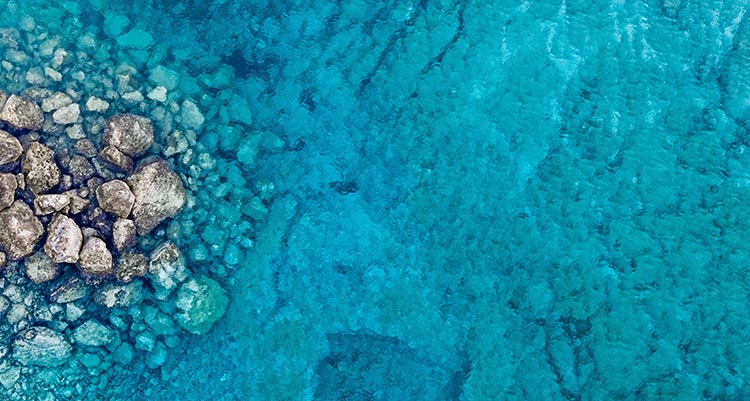
Home / Destinations
Explore Sicily
PALERMO
Palermo
Palermo, Sicily’s largest city is quite known for the noisy and crooked streets of its city center, often leading to hidden jewels like ancient churches, cloisters, baroque palaces, old ruins and artisans shops. The town, having been the crossroads of civilisations for millennia is a pout-pourri of architectural styles, mixed cultures and amazing cuisine. The city center, which is one of the largest and most interesting in Europe, has a slew of monuments of which the most important are: the Cathedral, the Norman’s Palace, Piazza Pretoria and the Teatro del Massimo, Italy’s biggest opera house. They are all within walking distance of one another and well worth a visit, especially if stopping by the ever-growing number of vibrant and new eateries, bars and restaurants for the local food and wine is a part of the visit.
Palermo’s city center is also quite well known for its night time entertainment, with streets like Via Ruggero Settimo, Via Maqueda and Via Isidoro la Lumia, just teeming with cocktail bars, dance clubs and small local clubs dedicated to partying and fun. Not to be left out from a visit to the city are either of the city famous arab markets: La Vucciria and il Mercato del Capo, places where the full spirit of the ancient arabic root of the city can be felt at its fullest. Suk like markets during the day, here any type of food and spices known by man can be found, freshest of the selection and by night small local shops and ambulant cooking carts will give you a wide selection of the typical street food and popular entertainment.
Palermo’s coastline is also known for its wonderful landscapes: long beaches, cliffs and small maritime villages including Mondello, Sferracavallo, Isola delle Femmine and San Nicola, all beautiful stops on the way to the Aegadian islands. Here anchoring is always comfortable since the bays offer sandy bottoms and sheltered mooring places for the night, but also an opportunity to swim in crystalline waters during the day. Here the view of the landscape, from the preferred seaside look, will make you surely fall in love! On the east side is Mongerbino, with its Faraglioni, enormous shelves coming out of the sea and Sant’Elia, the smallest and most romantic of the Sicilian seaside villages, surrounded by the fascinating promontory of Capo Zafferano, one of the main promontories of the northern sicilian coast.
These too are good places to enjoy the day or spend a night at anchor on the way to the Aeolian islands.
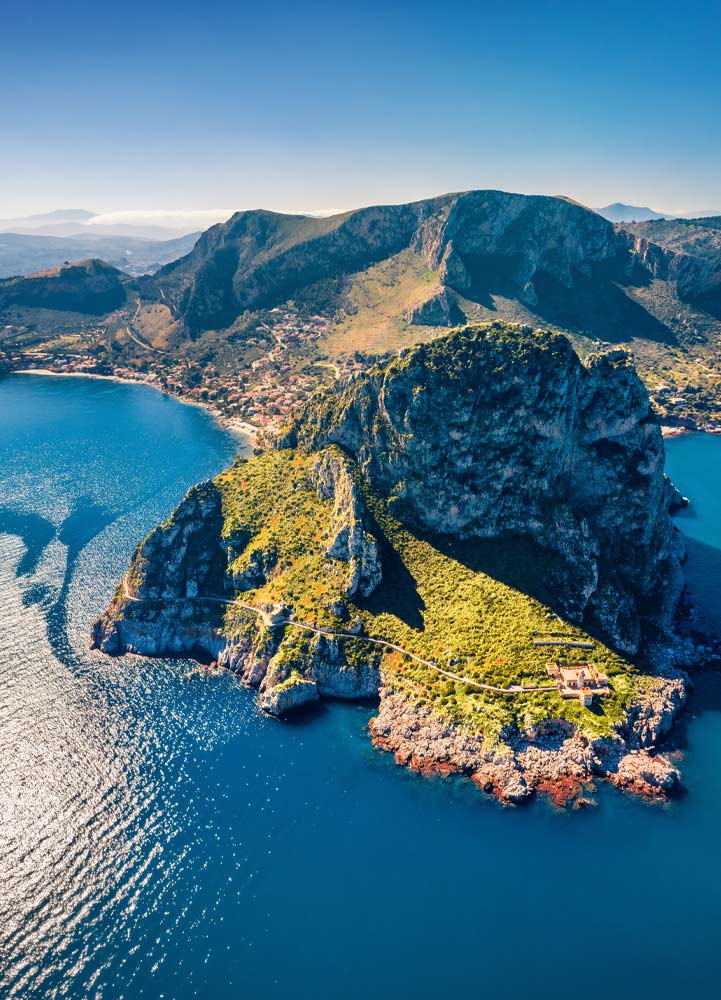
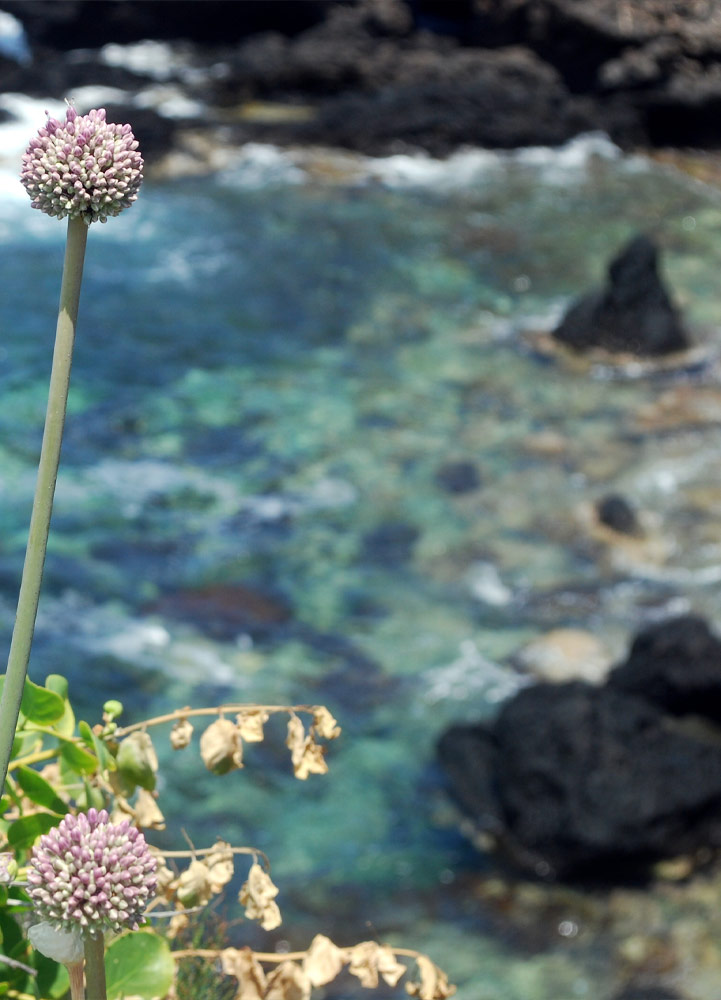
USTICA
Ustica
Ustica is the nearest island to Palermo, so near in fact that on a clear day it can be seen from the city, down to the small white dots of the houses,being just about 30 nautical miles away from the harbour of the main sicilian city. The island is characterized by very craggy cliffs and high, dark rocks that make up the coast and are the perfect nesting spot for many birds. Thus the true beauty of Ustica is not to be found above the water level but below, in the water depths and in the underwater life and grottos.
The entire isle is a marine protected area where fishes of every colour, form and sizes have their heaven away from fishers and are so accustomed to being hunted, that getting very near is quite easily achieved. The island offers many scuba diving centers, to enjoy the underwater landscapes, they rent out the equipment and help to set up the perfect day excursion.
Though for those who are not divers, even an apparently simple snorkelling experience might reserve some very special encounters. The best way to enjoy the island of UStica, is for sure from the perspective of a boat at sea, be it a sailing boat, a comfortable catamaran or a fast motor boat. There are in fact quite a number of bays to be enjoyed and buoys to moor the boat at and enjoy time on the land, in the main village in fact it is possible to enjoy a typical Sicilian dinner and spend a fun evening on terraces looking at the sea panoramas.
A beautiful sunset with a sparkling glass in your hand will be just the perfect closure to a day spent enjoying the underwater spectacle of Ustica.
TERRASINI
Terrasini and Balestrate
Navigating to the west side of Sicily from the city of Palermo and about ten nautical miles away is Capo Rama, one of the promontories of Sicily and since the year 2000, a natural reserve because of the vast acres of pigmy palms, typical of the mediterranean scrubs ecosystem. Just passing Punta Raisi, where the Airport of Palermo is located, there are the quaint and enchanting villages of Terrasini and Balestrate.
Terrasini, with its marina adjacent to the beautiful beach of Magaggiari and the characteristic coast made of red rocks and torrions like shelves coming out of the sea, is a true jewel. The town center is full of restaurants where you can eat freshly caught fish and enjoy the high party life, thanks to a quite youthful population.
The coastline, with its many beaches is the preferred spots of surfers and wind sports enthusiasts of the area, thanks to the good wind condition year around. Balestrate, embraced by its two golden sand beaches, made mostly of powdered tuff rocks, offers the occasion for a sleepy and relaxing day at anchor. Both are ancient fishing villages, now transformed into renowned tourist attractions, that are a possible stop when sailing around Sicily.
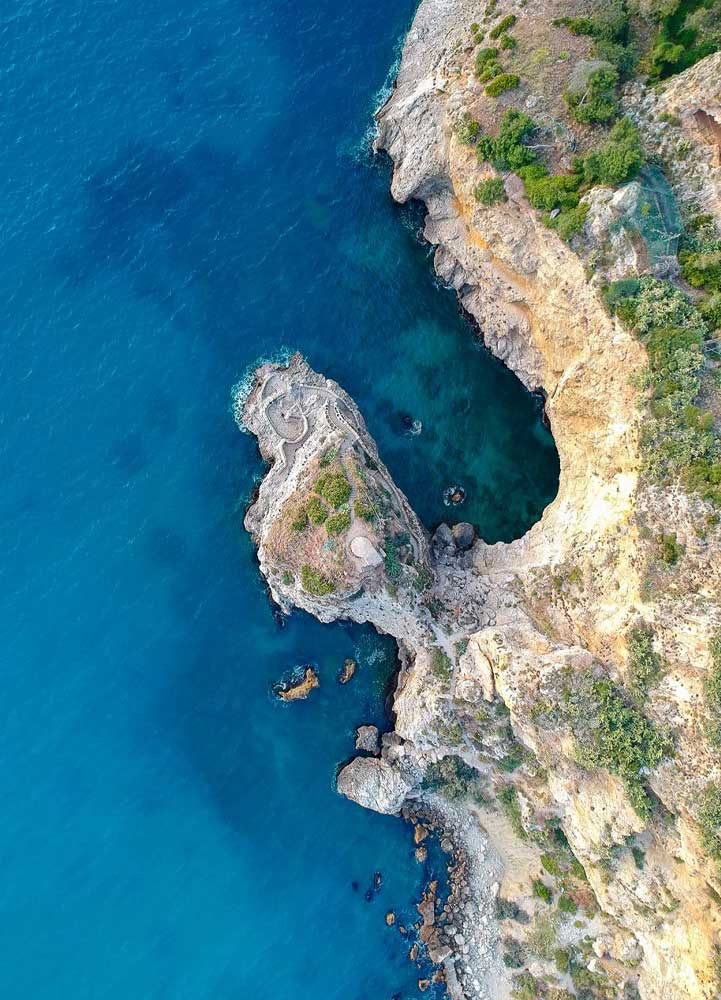
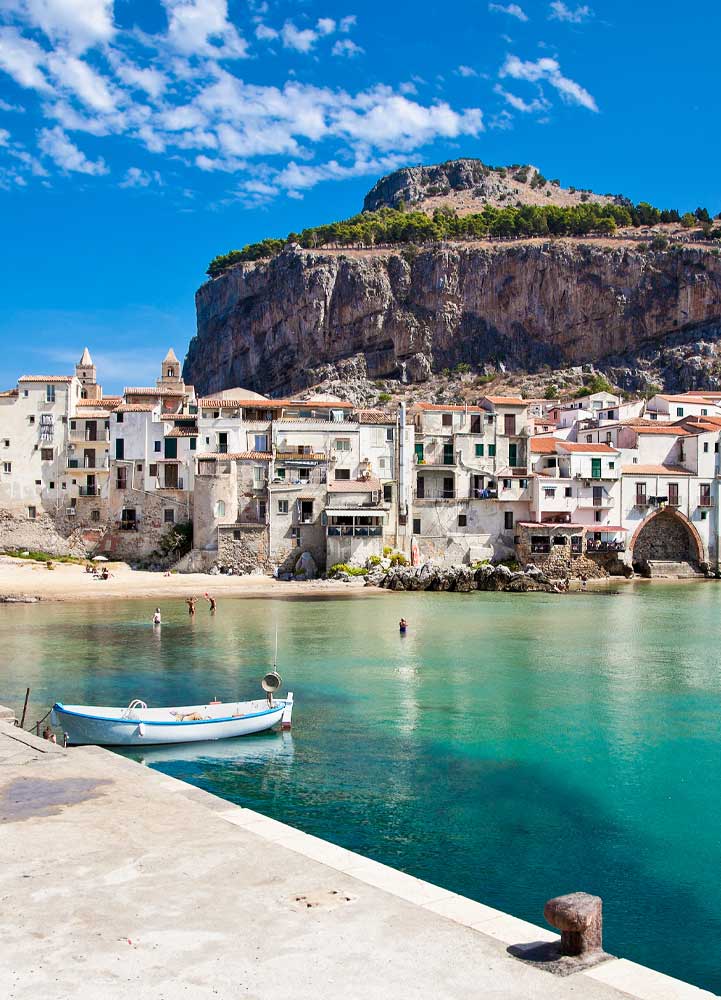
CEFALÙ
Cefalù
Cefalù is the midway point on the route to the Aeolian Islands, navigating from Palermo to the isles, this coastal city of Greek origins in the northern part of Sicily, is situated at a middle distance from the nearest of the Aeolians and is to be considered a perfect stopping point when navigating toward east. The city which derived its name from its situation on a lofty and precipitous rock, forming a bold headland (Κεφαλή) projecting into the sea offers one of Sicily’s finest beaches side-by-side with one of its greatest Arab-Norman architectural masterpieces: the Cathedral of Cefalù, a World Heritage Site.
The squares, streets, and churches of this medieval town are postcard-pretty with honey-hued stone buildings and narrow cobbled streets. Right below the mountain to the east of the inhabited center of Cefalù, near the imposing white lighthouse of Capo Cefalù, raises the port of Baia di Presidiana offering a wide range of services and shelter for the night and from where an evening stroll to the seafront promenade can be taken to enjoy a night in town, which is also know for the seaside clubs and restaurants that even from the apparent inland main street, hide beautiful terraces on the sea.
Fresh fish and good wines are always guaranteed, though we are at your disposal to make some pointed suggestions. The town coast also offers the possibility to drop the anchor, even just on the side of the harbour entrance, to spend the night and continue the navigation at a good hour to make a quick way to the Aeolian Islands.
AEOLIAN ISLANDS
Aeolian Islands
The 7 pearls of the Mediterranean sea, this is how people worldwide have dubbed the Aeolian Islands’ Archipelago and not without reason.
There is no end to the beautiful landscapes and amazing perspectives offered by this group of islands: the beaches, the bays, the hidden creeks, the unfathomable colors of the sea, but also the fantastic views from the mountains and volcanoes, the spiraling streets that traverse the typical white houses with their bougainvillea fuchsia flowers, the food, wine and finally the inhabitants themselves make of this one of the best loved destination in the Mediterranean sea and comparable only to the most precious treasures created by the sea.
A great majority of the visitors come to the islands with a boat: be it the showier privately owned yacht, small motorboats or rented sailing boats and catamarans, coming by ship seems to be the preferred way. In fact visiting the Aeolian Island by this means remains without doubt the best way to see all of the islands and get to know their every facet. Renting a sailing boat or catamaran for a week or more is a good solution to explore the whole archipelago since the visitors are then able to enjoy a complete visit, an affordable place where to sleep and eat and the possibility to participate in land and sea excursions by day and night.
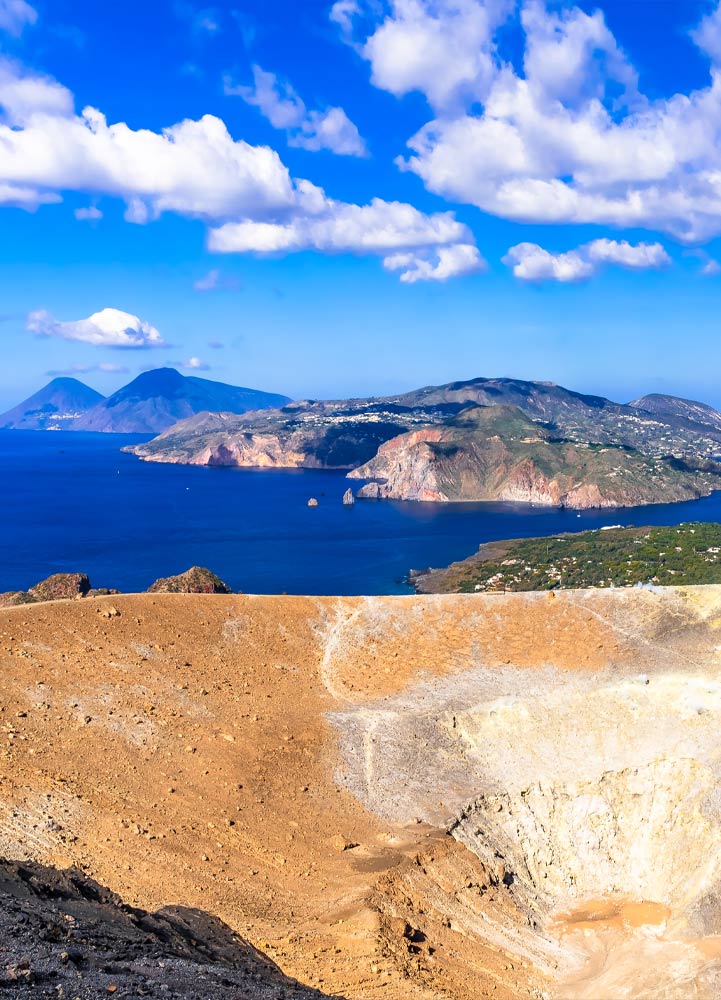
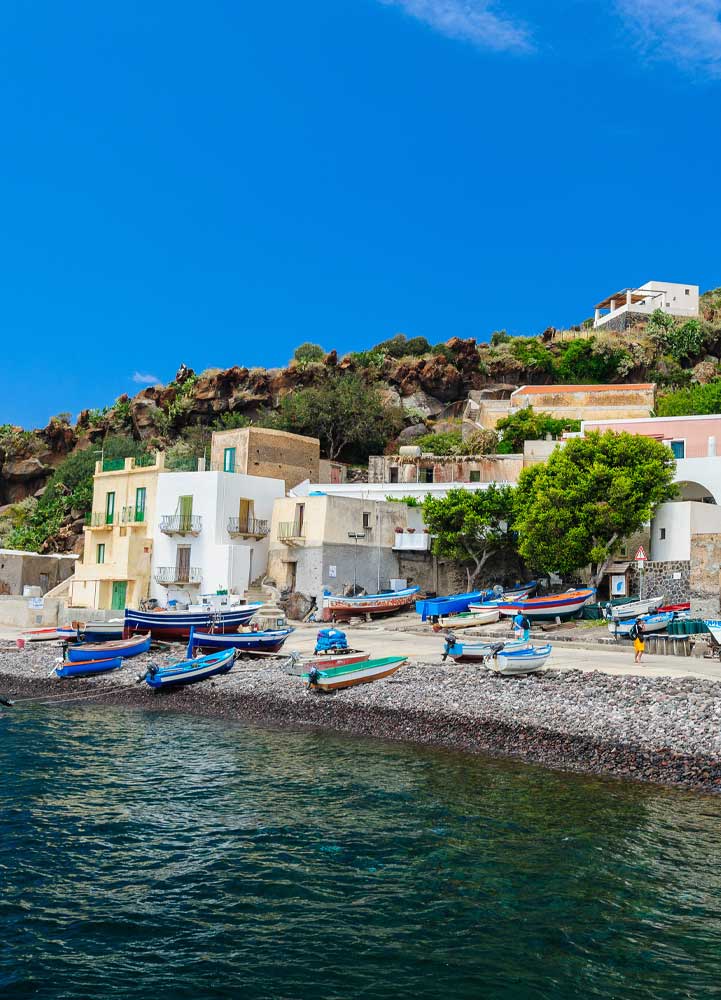
ALICUDI
Alicudi
Small and uncontaminated, Alicudi is a circle-like islet in the mediterranean sea. There are no bays or coves and no shelter to stay moored in the night, so when visiting by boat it is not possible to stay the night, unless getting one of the few buoys available is an option.
Alicudi is between 20 and 30 nautical miles away from the larger islands of the Aeolians. The inhabited part of the island is very small, with beautiful small white houses, with terraces on the sea, typical of the Aeolian architecture.
Donkeys remain the preferred method of transportation for their nimbleness in climbing the little streets, that are largely not big enough for cars or other methods of transportations.
The main attractions, after the village of Alicudi Porto itself and the little church, that can be reached by climbing a number of steps are Punta Rossa, the rock called Scoglio Galera, good for scuba divers and snorkeling enthusiast, Punta dello Scario Vecchio, which was the former dock of the island and the natural arch-shaped rocky formation of Arco Perciato.
FILICUDI
Filicudi
Filicudi is characterized by a profile that is startlingly similar to that of a pregnant woman lying on her back, so much that many call her the mother of the Aeolian islands, a calling name that is not far from the truth as the volcano that once was the island and of which only the mouth remains, in the form a turret like shelf called La Canna, is the oldest of the islands.
Today the isle is formed by two mountains: Monte Fossa delle Felci, whose southern slopes are steep and uninhabited and Capo Graziano, where the well-preserved rests of the prehistoric village can still be visited. There are two main settlements, one is Pecorini a Mare, the one with the biggest harbour and with a buoy’s field in front of the main village road, that is dotted by a couple typical restaurants.
The other harbour and village is Filicudi Porto on the other side of the isle, where one of the best sicilian granita of the islands can be tasted. Stops not to be missed are Punta Perciato, another arch like shelf structures just near the entrance of the famous cave called Grotta del Bue Marino, the Scoglio di Montenassari, a beautiful spot for snorkeling and La Canna, a 70 meters high rock formation that resembles a tower and former lava conduct of a volcano that is now part of the marine depths of the island. The place is also well-known for the wonderful seabed which does not exceed 18 meters of depth and is a perfect and quite scenographic swimming spot.
For scuba diving enthusiast Filcudi is quite the right place, the collection of wrecks on the seabed is protected as an Underwater Archaeological Park, giving divers the opportunity to immerse themselves in a world of ancient Greek anchors and ships buried in the sand. Filicudi also offers one of the best sunset of the islands, letting one-self be carried by the wind while the sun goes down behind Alicudi, is an experience like few others and going back to the village of Pecorini a Mare to enjoy a cold drink and some local food is just an added bonus to the experience.
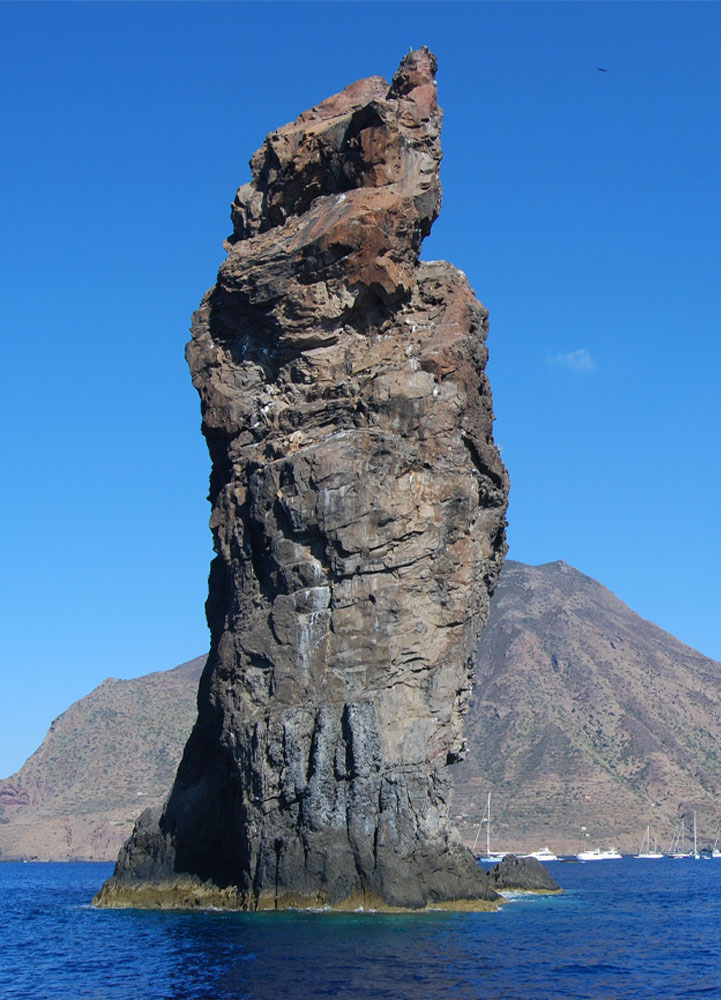
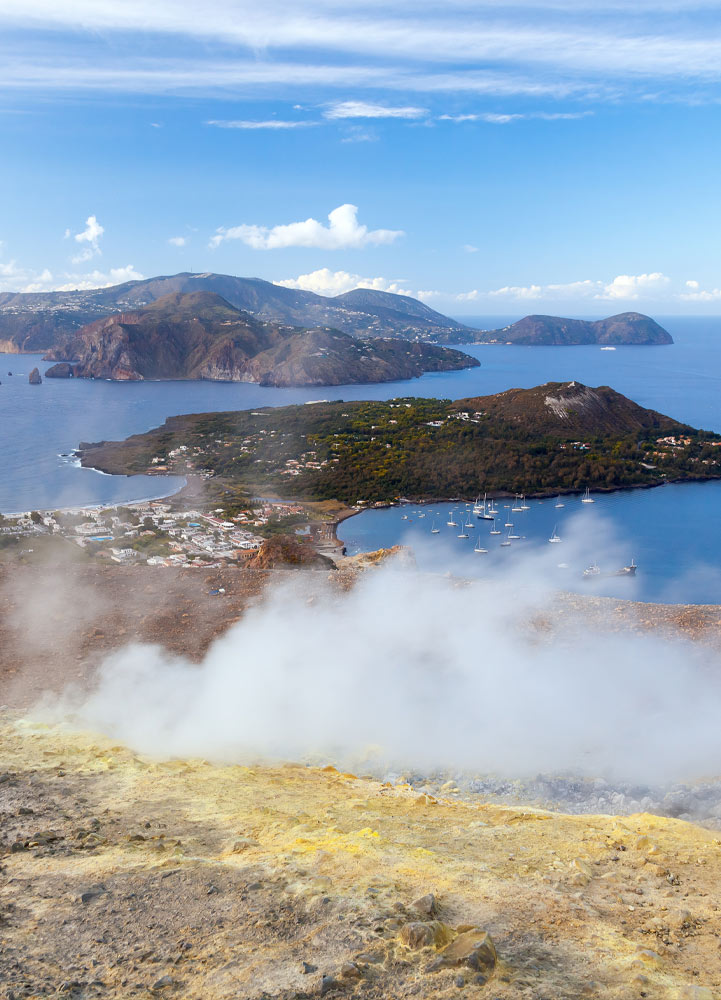
VULCANO
Vulcano
The Island of Vulcano, with its smoking crater and sulfurous fumes is generally the first island to be reached when starting from the Marina of Portorosa, from which it is distant just 14 nautical miles.
The island is characterized both by the white lighthouse that dominates one of the main bays of the island, by the therapeutic mud baths and hot springs and a quite famous spot called the Pool of Venus on the west side of the island. Fossa di Vulcano (or Gran Cratere), is the steaming volcano that towers over the island’s northeastern shores, many excursions are organized every day to climb it and enjoy a view of the entire Archipelago and Sicily too, but also to enjoy the view of the sulfur fumes still spouting from below the rocks.
Other interesting places to visit are the mud baths and the black sand beaches at Porto di Ponente, but also the volcanic beaches of Gelso. There are two harbours in the islands, Porto di Ponente and Porto di Levante. They are situated specularly on each side of the island in between the main mountain and the peninsula of Vulcanello, so with any wind condition either one side or the other will offer shelter.
There are buoys and even wood floating piers on both sides.
LIPARI
Lipari
Lipari is the largest of the Aeolian Islands, and also the one who gives the more international name to the archipelago. They are in fact also called the Lipari Islands. The island is also the seat of the municipality. It is situated about 22 nautical miles from Portorosa, and so, just like the others, it is easily reachable by a sail boat or a fast boat.
Lipari offers many bays to visit, cliffs of white rocks and high turrets like shelves just off the coast, but also the inland offers many beautiful and amazing places to visit and plan an excursion to. Lipari harbour is the biggest village, might also be called a town, on the islands. It offers many marinas, like Marina Lunga, with many wooden pontoons and Pignataro harbour, one of the safest harbours in the marina in case of strong winds. On the main boulevard of the town there are many typical restaurants and cafè, though the best place to enjoy the evening remains for sure the main square in Marina Corta, the old fisher harbour.
Lipari is quite famous for two main attractions: the faraglioni, high rocks coming out of the sea and characterized by windows like holes at their bases on the south-west side of the island and the white cliff of pumice stone, between Porticello and Spiagge Bianche on the north-est side of the island. This part of the coast is quite peculiar as the excavation in old times of the white volcanic rock, caused a great quantity of white sand to be poured in the waters surrounding the mountain, covering the sea bottom with white sand and thus creating an enchanting azure colored bay where is is possible to drop the anchor and enjoy a swim in the very peculiar colored waters.
Others places worth a visit are Canneto with its long, quiet sandy beach and Porticello itself, in the north of the island, a beach made entirely of very small pebbles. Lipari also offers technicians for any kind of problem, ATM, supermarkets, the hospital that serves the whole archipelago and pharmacies. Lipari is also the main seat of many diving centers, where it is possible to organize scuba diving tours, by renting also the equipment, to all of the islands.
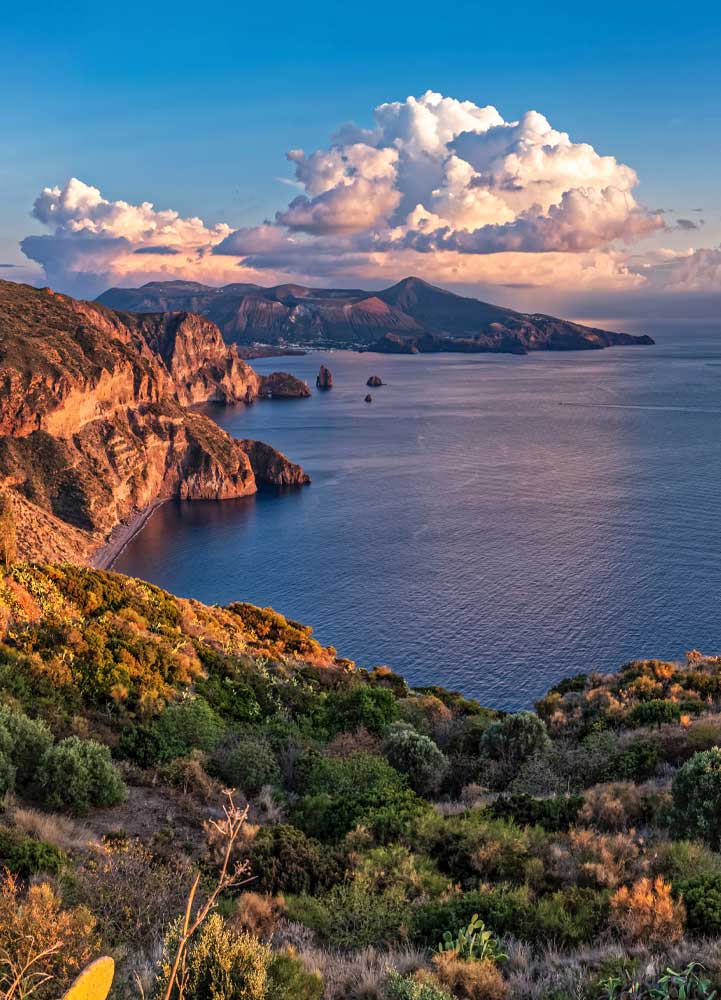
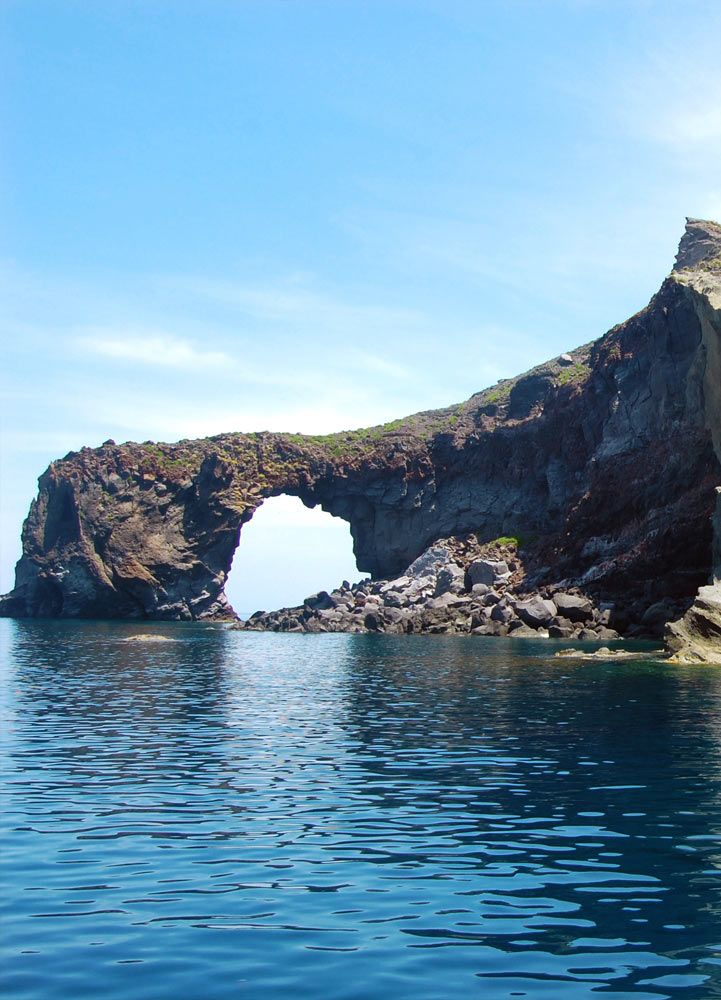
SALINA
Salina
Salina is perhaps the most famous of the Aeolians and surely worth a visit. The harbour, Santa Marina di Salina with its Marina di Salina, is a very large stone harbour and one of the places to go in case of strong winds.
It is a typical island settlement with steeply stacked houses rising up the hillside and a pedestrian-only street lined with cafes, boutiques and the colored facades of the villas in the typical aeolian architectural style. Three kilometers south, the tiny village of Lingua is a popular summer hang-out, with a few trattorias to taste the typical Aeolian cuisine and a place known across Sicily, for its flavourful granita and the typical filled bread called pane cunzato, Alfredo.
Others places to visit are the sleepy bay of Pollara, sandwiched between the sea and the steep slopes of an extinct volcanic crater on Salina’s western edge, whose gorgeous beach was used as a location of the worldwide known film, Il Postino and which is a preferred spot for sailing boats, catamaran and fast boats. Finally, Malfa, a settlement on Salina’s north coast, where a beautiful panorama point is a preferred tourist attraction, to go and enjoy the sunset with a view on the other islands.
Salina is also quite known for the vineyards of famous wine producers like Planeta and Hauner, that can be visited with tours to try their wines and see the production sites. Finally, Salina is the places where the production of the capers is quite developed, a place called Al Cappero, offers not only the possibility to discover all there is to know about the plant, but also try out typical dishes made with capers as the main ingredient and bring some home, to try and replicate the recipes!
PANAREA
Panarea
Panarea is one of the most fashionable islands of the Aeolian Archipelago. It is all in all a small island, with few settlements, of which the most important is the tiny harbour of San Pietro, just a small stone jetty for the hydrofoil and a few local small boats find place here, if one excludes the dinghies of the sailboats and catamarans vacationers.
The streets of San Pietro are made of volcanic stones and present a net contrast with the whitewashed villas of the island, narrow and curving roads connect the houses from the coast and going up to the hills, and it is a real pleasure to navigate them and discover restaurants, boutiques and clubs. The islands of Panarea is the preferred destination for VIP, with many renowned clubs, like the Raja, a fashionable terrace with a view on the other islands or also a very exclusive sushi bar on the main road and i Geki, a local meeting point for good music and a the typical island’s aperitif.
Points of interest are the prehistoric village of Punta Milazzese south of San Pietro, where there is also a gorgeous little cove with a rock-strewn beach and dreamy aquamarine waters called Cala Junco, which is one of the island’s top destination and Cala Zimmari, another beautiful bay to drop the anchor on a sandy sea bottom. But the most amazing stop in Panarea remain for sure the small group of islets and rock cliffs off Panerea’s eastern shore: Dattilo, Lisca Bianca, Lisca Nera in between which there is a good point to drop the anchor and swim among the underwater geysers and Basiluzzo, a gorgeous islet of striated limestone and emerald waters, which is also known as the Sea Cathedral. Enjoying a sailing holiday among these locations is for sure an experience to be remembered.
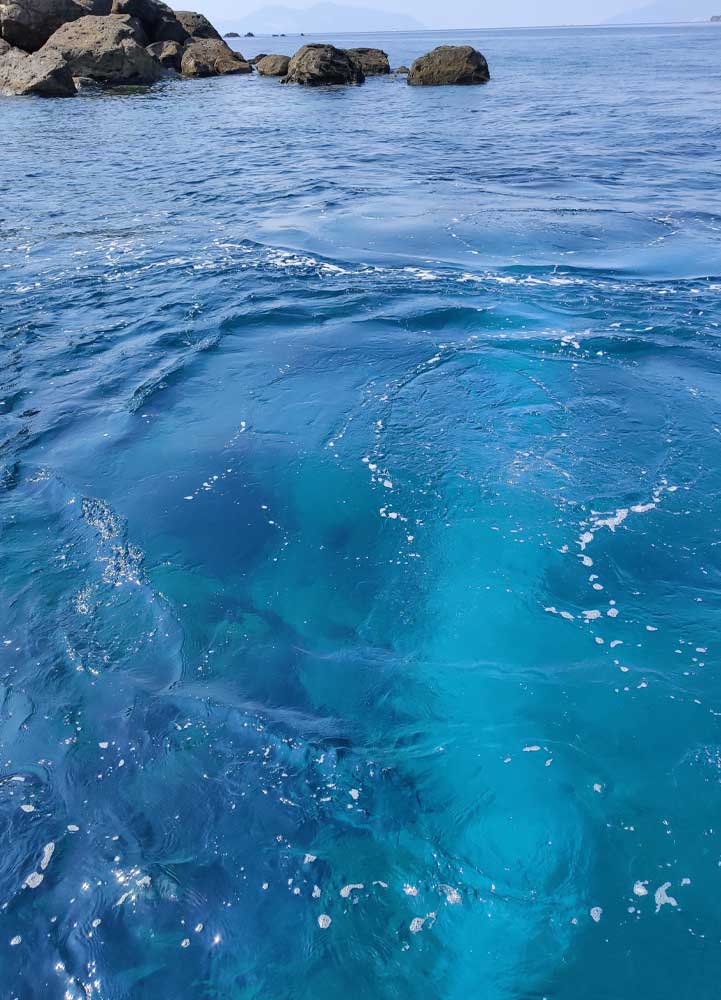
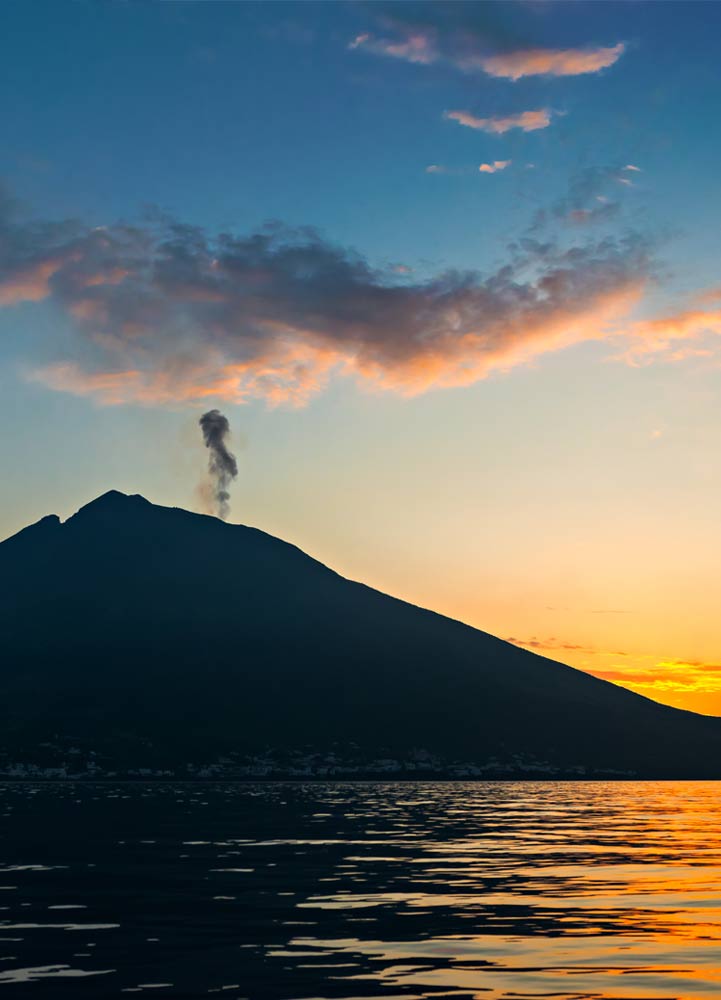
STROMBOLI
Stromboli
Stromboli rises like a gentle giant from the sea and its symmetrical, smoking silhouette, perhaps the most captivating of the Aeolians, can be seen from quite afar. It is for sure the farthest island from the Sicilian coast being just shy of 40 nautical miles away from the north-eastern coast, but for sure a trip to the Aeolians cannot be called complete unless one is able to reach Stomboli.
The volcano is still active these days and offers a continuous spectacle of smoke poufs in the day and red lava fountains in the night. Sailing along the side of the Sciara del Fuoco, the side of the islands where the current volcanic mouths are situated, is an experience with no equals both by day and by night. Even though there is a distance to be kept, the island is so big and the lava fountains so high and luminous, that there is no issue seeing them also from afar. Trekking to the top, with a guide, or even alone to the first observation point, is also an experience to be recommended. The island’s main town is San Vincenzo, a sprawling village of white houses and winding roads going from the black sandy shores up along the slopes of the volcano, here restaurants, boutiques and cafes offer a great experience to the visitors.
Other points of interest are the black sandy beach of Ficogrande and Piscità, made of black volcanic sand and Forgia Vecchia, the old mouth of the Stromboli, a long stretch of black pebbles curving around a tranquil bay and backed by the volcano’s green and black slopes. Also not to be missed is the tiny settlement of Ginostra, on the island south-western side, here there is first of all a beautiful stopping point for a swim, a place called by the locals Le Piscine ( the swimming pools) a shallow point of the bottom, with emerald coloured water starkly contrasting with the black and reddish brown color of the steep shores and also a visit to Ginostra itself. The steep climb from the old port to the village is worth the fatigue.
A sunset like no other in the islands can be admired from the main square, all with a cold beer or wine glass in the hand! Enjoying the peaceful sight of the sun going down below the horizon and bathing the silhouettes of the other islands in lilac and orange tones is an experience out of this world. Another spot not to be missed is Strombolicchio: an impressive rock-islet topped by a lighthouse. Climbing atop is strictly prohibited, but some daringly go anyhow. Still remaining lawfully nearby is the best place for a swim and a spot of lunch with a breathtaking panorama.
CASTELLAMARE
Castellamare Del Golfo
About 35 nautical miles west from Palermo is the small coastal town of Castellammare del Golfo, situated in the middle point of big gulf that takes its name from the town, this quaint sicilian town is has a very beautiful harbour, surrounded by steep cliffs and pine forests. The coastal landscape is rich in coves with emerald and azure waters that invite the sailor to stop and take a swim. Castellammare harbour is overlooked by the remains of a Saracen castle and surrounded by sandy beaches.
The place is suitable for spending the night at anchor in the emerald waters that characterize the place, or in one of the many marinas in the harbour or for a swim at the beach just next to the port. Added to all this are the ancient ruins of Segesta, only a short drive inland and the natural hot water pools in the vicinity. A fiery red cliff closes the eastern slope of the gulf and offers good shelter from the winds.
Going north from Castellammare, there is Cala Bianca, a spectacular cove that takes its name from the white colour of the sea bottom and many other little coves and creeks can be encountered while navigating north in the direction of San Vito Lo Capo, the western most limit of the big gulf. Fish restaurants dot the street winding around the harbour and offer all kinds of sicilian wines and cuisine.
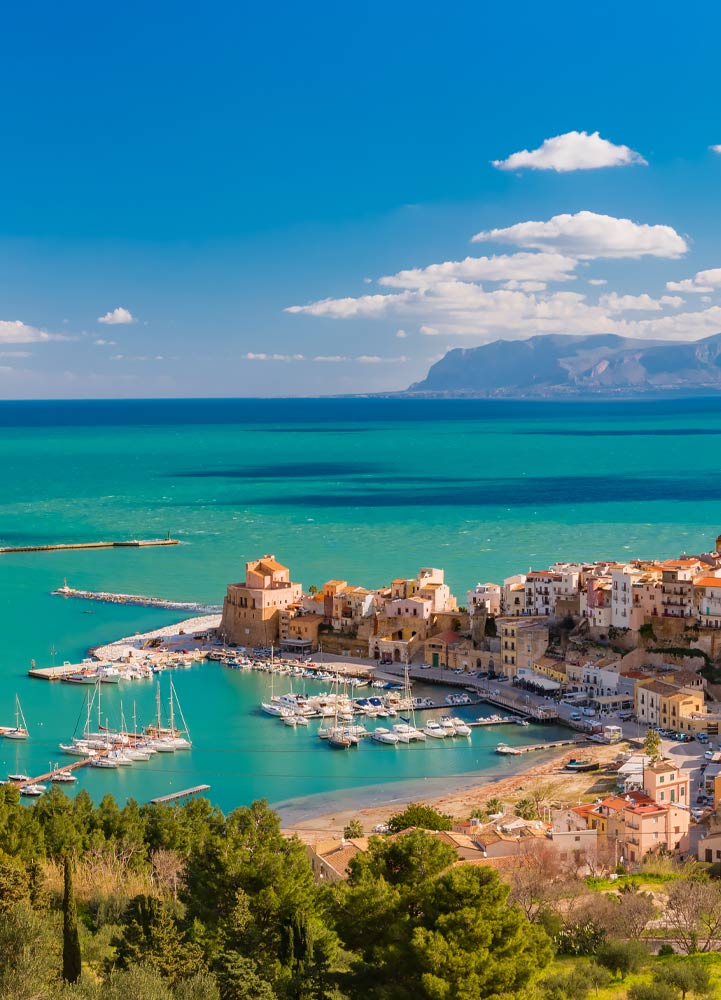
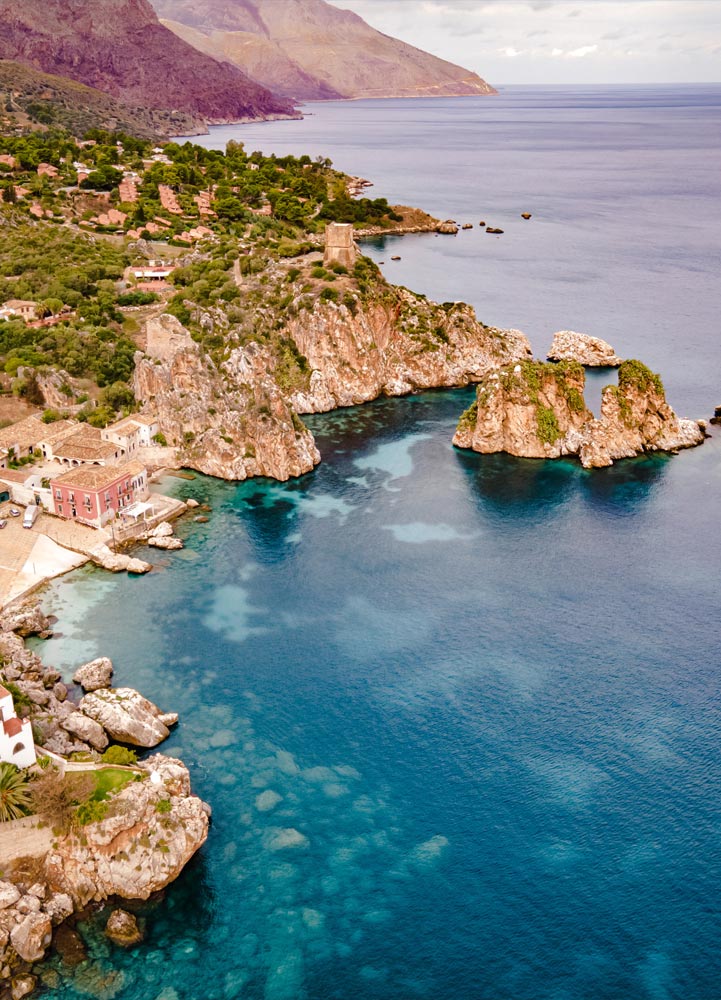
SCOPELLO
Scopello
This amazing creek in the Gulf of Castellammare del Golfo, is a preferred spot for dropping the anchor of sailboats, catamarans and ribs or fast boats in the area. The Faraglioni di Scopello, quite renowned in the sea lovers world, are best reached and enjoyed from the sea point of view, though some venture also from the land.
Here an old tuna factory has nowadays been transformed into luxury B&B, with very spectacular views from its rooms. The rock pillars jutting out of the aquamarine sea are a breathtaking backdrop and the natural entrance to the natural reserve of Lo Zingaro, which with its many botanical varieties delimits the western coast of the gulf.
This bay is also very famous for being the home of a big pod of dolphins that are quite often viewed jumping through the water or following boats. Scopello is also quite famous for two sicilian specialities that can be bought at the Borgo, the medieval styled settlement, atop the bay. One of them is a sweet: the Cassatelle, a very slim dough in the form of a crescent moon, fried and stuffed with fresh ricotta and chocolate chips and one of them is a salty delicacy: the Pane Cunzato, a very rustic bread baked in a wood oven and seasoned with olive oil, anchovies, tomatoes and sheep cheese.
SAN VITO
San Vito Lo Capo
San Vito Lo Capo, is perhaps one of the most famous beaches of Sicily. Its sits a the tip of a promontory that delimits the west ending point of the Gulf of Castellammare and is quite renowned for its crescent-shaped sandy beach and limpid turquoise and ultramarine waters juxtaposed against the dramatic mountain backdrop of Monte Monaco.
San Vito Lo Capo is the perfect midway point when navigating toward the Aegadian Islands from Palermo. The harbours offers many piers with all the services and many restaurants and entertainments for those spending the night in port or moored in front of the beach. About 10km southeast of San Vito is the nature reserve called Riserva Naturale dello Zingaro, an area rich in caves and spectacularly hidden creeks like the one of Macari, recently made more famous by a tv series. San Vito is quite renowned for its fish couscous, which is celebrated annually in September with a festival involving musicians and chefs from around the world, with a couscous cook-off and couscous workshops given by chefs from San Vito, Trapani and North Africa.
Another typical food of this town is a type of ice cream called Caldo Freddo that is served in a cup and covered with hot chocolate, hazelnuts or pistachios. For sure a place to visit when enjoying a sailing holiday in Sicily!
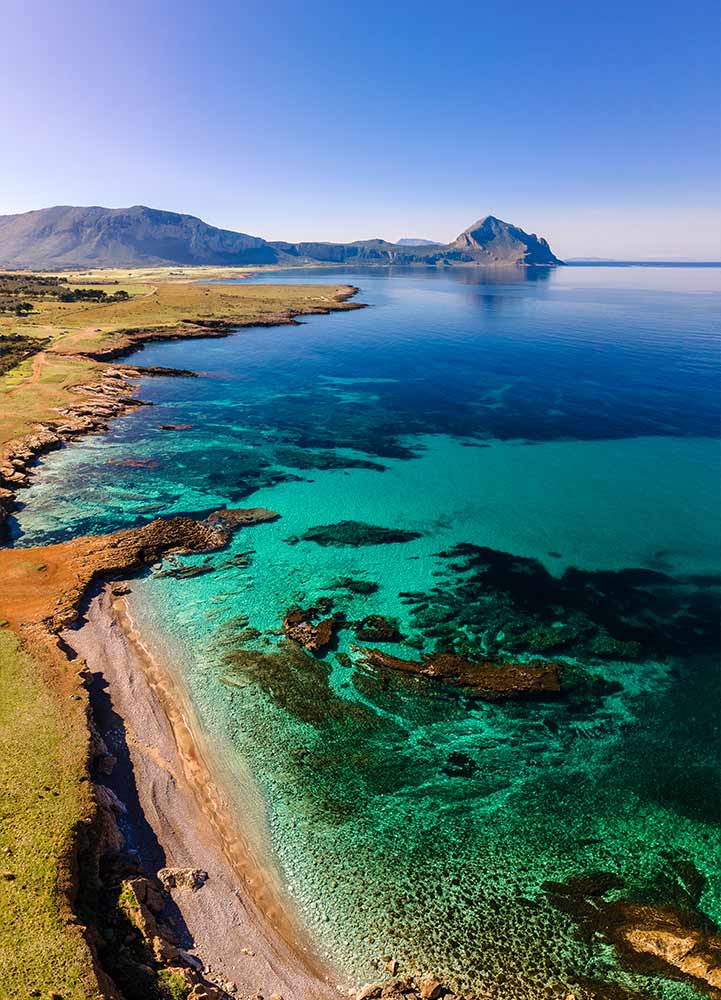
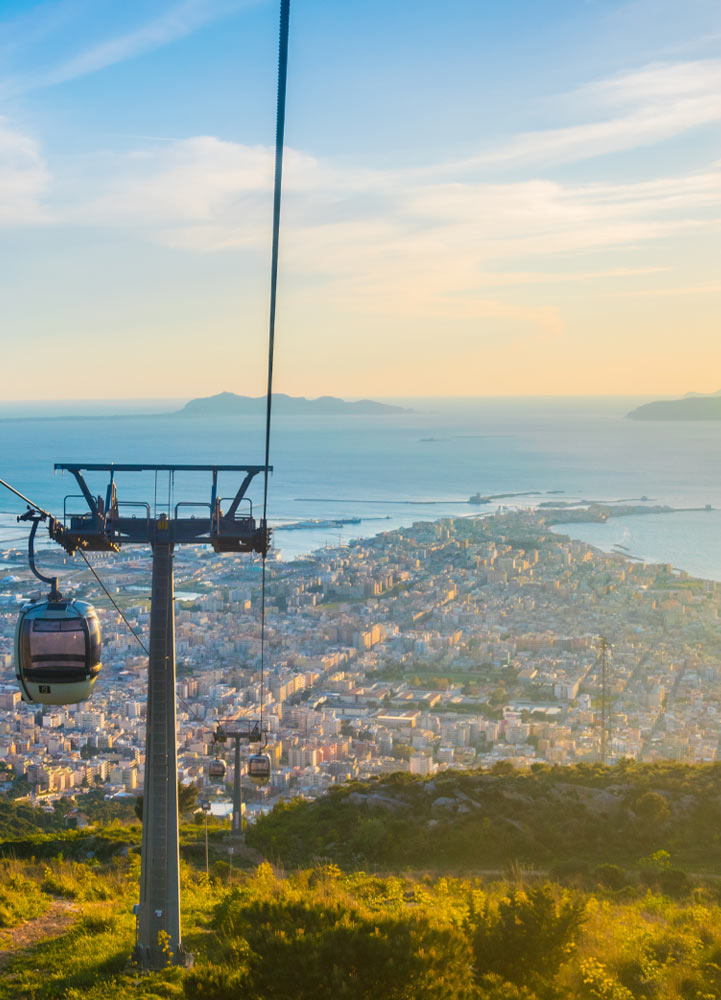
TRAPANI
Trapani
The amazing city of Trapani is quite known for the offers harbour, a stop of the 2007 America’s Cup, and for its historic center, barred to vehicle traffic, popular to stroll and eat typical Sicilian food for both locals and travelers. The old town, extending westwards with the sea on either side, is a fulgid example of a typical sicilian town: old palazzi, some crumbling and some grand, cluster along the promontory around the central Corso Vittorio Emanuele, churches in various architectural styles and small boutiques selling artigianal creation, like jewels made of reef coral and mother of pearl.
A stroll around the largely-pedestrianised old town gives travellers a chance to admire the town’s old buildings and landmarks such as the offshore fortress called Torre della Colombaia or Castello del Mare (Sea Castle), the town’s restored cathedral, called Cattedrale di San Lorenzo and the church called Chiesa del Purgatorio, the home of the sculptures which are carried through Trapani during the town’s famous Easter procession and at the very tip of Trapani’s headland, the Torre di Ligny, a tower which was part of the 17th-century Spanish defences. Around Trapani, places of interest include the medieval walled hill-town of Erice, that can be reached through a cableway and offers a view over the city and the not so far away Egadi Islands and the ancient Greek site of Selinunte, where the best-preserved temples in all of Sicily are located.
Sailing enthusiasts will remember that in 2007 Trapani was part of the America’s Cup. The choice of location was motivated by the wind. In fact, in Trapani, the wind is constantly blowing though strangely it does not particularly affect the waves. Long tacks can be made navigating up to the rocks of the Porcelli, 3 miles northwest of the city or to the rocks of the Asinelli, 4 miles northeast. Trapani is quite famous for its enogastronomic wonders, among the local dishes that should be tried at least once are innumerable types of Couscous, which are a trademark of the whole west coast and Pasta with bottarga (tuna roe), but also the Rianata, a rustic pizza seasoned with a startling quantity of oregano, garlic and anchovies and the Patata Vastasa, a baked potato with spicy cheese and tomato.
MARSALA
Marsala
Crossing the extreme western tip of Sicily and overtaking Trapani, about 20 nautical miles further south lies Capo Lilibeo and the city of Marsala. The harbour of Marsala, is situated just in front of the Egadi Island and from this vantage point it is possible to reach the archipelago in just a bit more than a couple of hours, if starting from this vantageous point with a sailboat, a catamaran arriving in the south of Favignana in time to enjoy the sunset is guaranteed. If travelling with a fast rib boat even enjoying a refreshing swim in just an hour will be true.
Marsala is quite known for the sweet dessert wines, with the local vineyards organizing aperitifs with marsala tastings and typical dairy products, but the city itself is quite a beauty with streets paved in gleaming marble, lined with stately baroque buildings and peppered with graceful piazzas that offer plenty of aperitif options and family-friendly restaurants. Turning north is a lagoon called Lo Stagnone, a true paradise for wind related sports like windsurf, kitesurf and more.
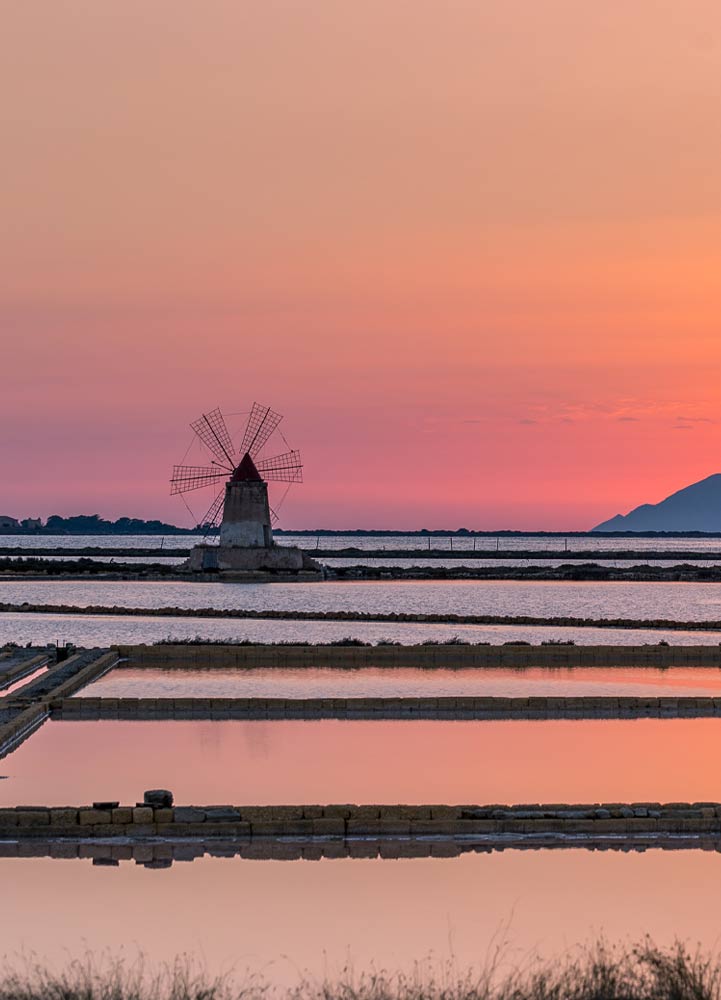
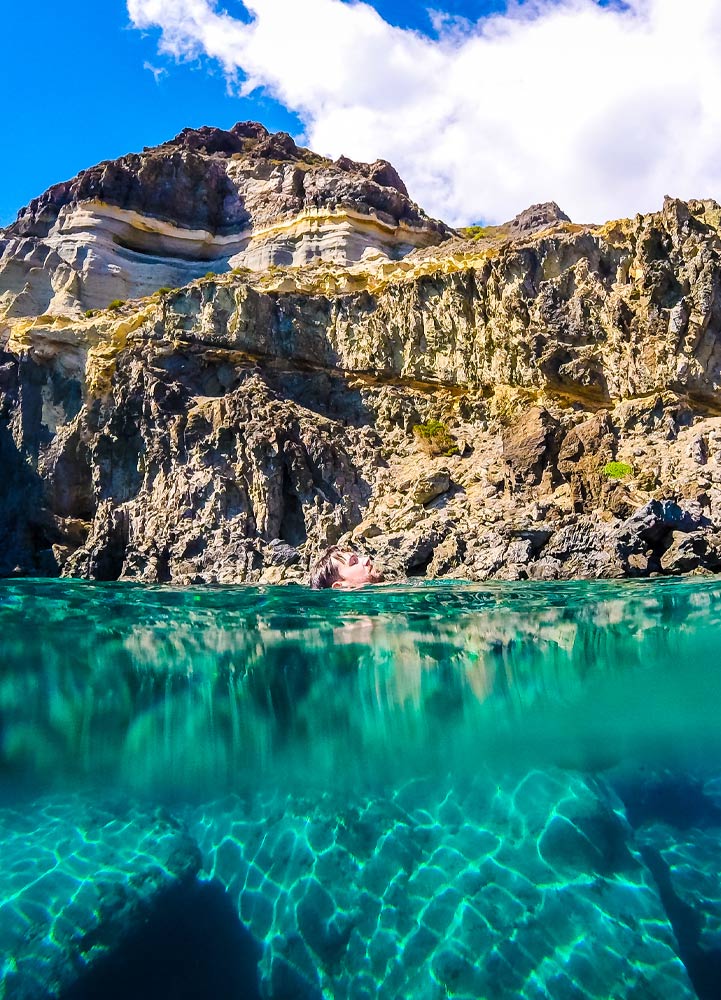
PANTELLERIA
Pantelleria
Pantelleria is located halfway between Sicily and Tunisia, the island is characterized by jagged cliffs, low-slung caper bushes, dwarf vines, steaming fumaroles and mud baths. There are no true beaches on the island, but Pantelleria is known for its gorgeous, secluded coves, including Cala Tramontana, Cala Levante and Balata dei Turchi, that are perfect for snorkeling, diving and swimming. Sailing to Pantelleria is perhaps not for all, as it requires at least 24 hours of constant navigation, though sailing at night is an experience to be made at least once in a lifetime.
The starry sky is a spectacle like no other, with thousands of stars visible to the naked eye so far away from artificial illuminations and the peaceful lull of the wind and waves. Reaching Pantelleria during the first ray of lights from the sun, is the gift for the long voyage. Many coves can be visited with a boat and among them are: Lago di Venere (Venus’ Lake), a natural lake that occupies the bottom of an ancient caldera in the northern center of Pantelleria and offers hot springs and sludge baths, but also a beach to swim and sunbathe.
The rock formation, called Arco dell’Elefante on the east coast of the island, which resembles an elephant that is drinking the seawater from its trunk. The Benikulà Cave, that is a natural sauna where escaping water vapor reaches a temperature of 38° C. Balata dei Turchi, a very beautiful cove with a great cliff plunging steeply into the emerald sea.
These are a few of the places, that will enchant the sailors reaching the islands. Among this the inebriating sweet wine called Passito di Pantelleria, made from grapes that have been left to dry and sweeten under the hot sun and among the steep and dark colored cliff the unique Dammusi, houses made of lava rocks, whitewashed walls, shallow cupolas, and cisterns for collecting rainwater that characterize deeply the island silhouette.
EGADI ISLANDS
Egadi Islands
The Egadi Islands are the most wild, nature oriented and also the most true to small islet life of the sicilian archipelagos. They are becoming fast a popular destination for swimming, diving, eating and general relaxation, but the people making them their home remain truest to their origin.
The geographic conformation of the islands characterizes them with shallow sea depths, sandy bottoms and amazingly clear water, that creates spectacular shades of cerulean and teal so that the impression is to be fluctuating in a swimming pool, with just the shade of the boat on the sea bottom to keep you rooted in time and space.
The islands are for the most part a natural reserve, so to sail, navigate and to drop the anchor in all the bays and coves a permit is to be requested in advance. And parts of the islands are unreachable if not with the help from the local population, the only people allowed and capable of ploughing those waters and bringing you near the coast to admire the grottos and tiny hidden coves.
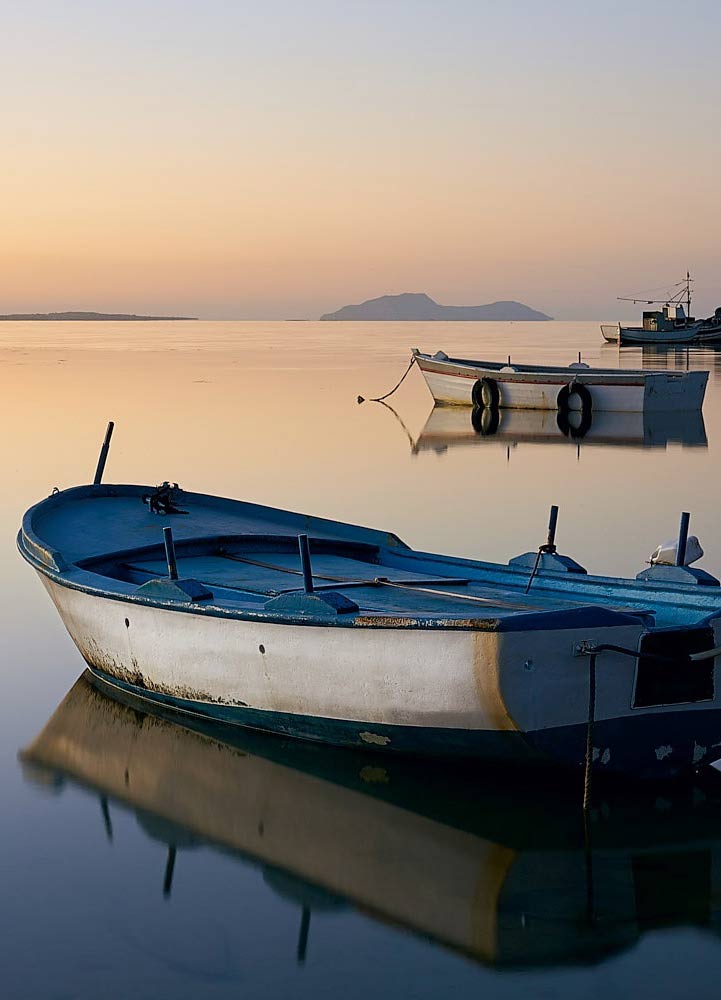
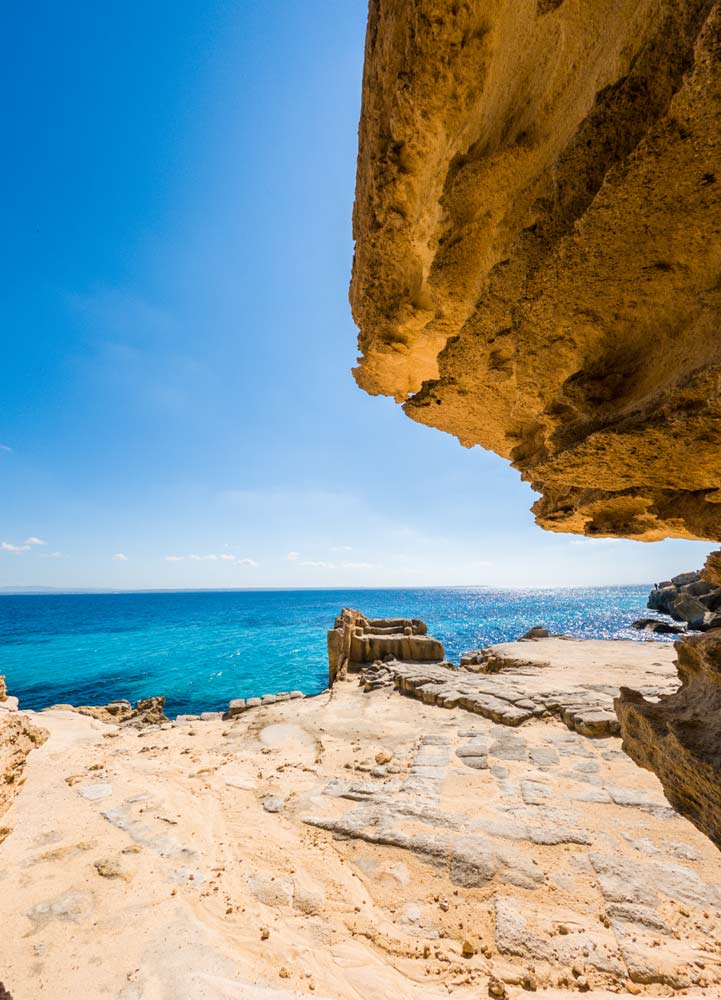
FAVIGNANA
Favignana
Favignana, or La Farfalla as it is often referred to thanks to its butterfly shape, is the largest and most important of the Egadi islands. It lies near the coast of Trapani and Marsala and is a popular holiday destination thanks to its crystalline azure waters in bays such as Cala Rossa and Cala Azzurra, the most beautiful of the island’s bays Lido Burrone, the sandy beach of Favignana, Preveto Beach, with its view on the likely named islets, Cala Rotonda and the Beach of the Bue Marino, all atmospheric swimming spots, to be enjoyed while visiting this caraibic watered jewel of the Mediterranean Sea.
Around the coast, deep gouges in the cliffs are reminders of the tuff stone quarries that were active in the past; many of these have now been reclaimed by the crystal-clear waters and are preferred locations for sunny days relaxation. Favignana town, the only substantial settlement on the island, is situated on the eastern side, it is a cheerful place with a friendly attitude to the tourists who arrive.
The Aegadian islands are intimately connected with the sea which surrounds them and scuba-diving and snorkelling are popular activities around all of the Egadi islands.
LEVANZO
Levanzo
Levanzo is the smallest of the Egadi islands, but a true jewel set in sparkling turquoise waters and dotted by pebbly beaches. The island’s little harbour is very picturesque: a small cluster of pale square buildings lining the main street, made of limestone colored tiles, winding down to an amazing teal coloured sea, where many are so enchanted by the view as to take a swim directly from the harbour main pontoon.
There’s one major tourist sight on the island: the Grotta del Genovese, not far above sea level, this cave contains prehistoric pictures of hunts, people, sea and land creatures. The picturesque shoreline street leads, passing along the isle’s pine forest to Cala Minnola, a little cove popular with swimmers and sunbathers and continues to Cala Fredda, which was named for the icy temperature of the water and is a beautiful stop if visiting the island by boat.
The island of Levanzo, also boasts a Lighthouse, that can also be reached by feet to enjoy the naturalistic side of the island and at the end of the road be amazed by the breathtaking panorama. Finally, the famous Faraglione islet is located right in front of the beautiful Cala Faraglione and is the star of many postcard picture like photos.
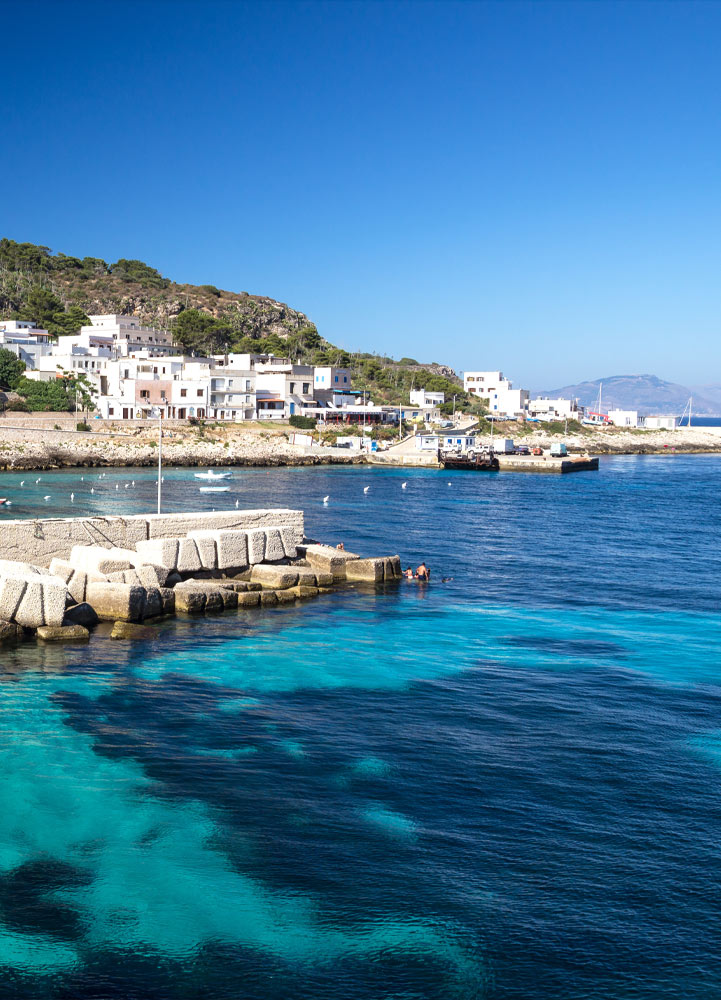
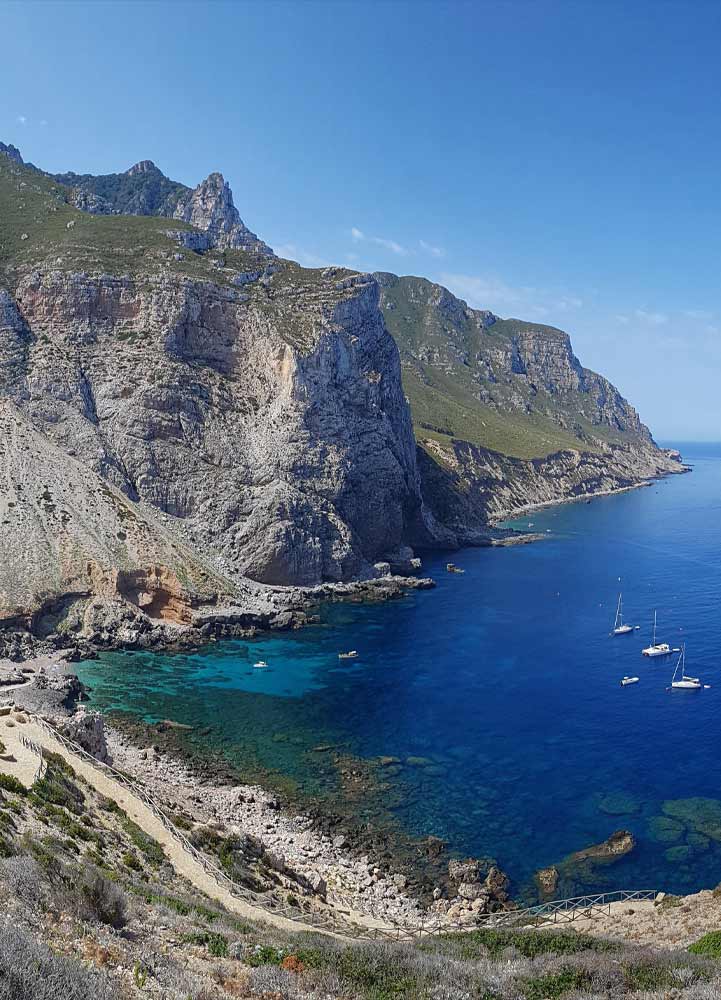
MARETTIMO
Marettimo
The wildest of the Egadi islands, Marettimo is a collection of green mountain peaks and white houses, with cerulean windows and bougainvillea tree-like plants dotted by white or deep pink flowers. The rocky shores of the village where the harbour, packed with bobbing boats, is ready to receive sailing boats, catamarans and small motor boats in summer with the addition of some wooden pier, is characterized by a central rock shelf on which a cross is mounted to protect the seafarers and is very dear to the locals. There’s only one main road on the island, and the main mode of motorised transport is electric carts, making this a prime destination for trekking enthusiasts and eco friendly tourists.
Fanning out in all directions from the town centre, a well-marked trail network leads quickly into unspoilt nature, climbing through fragrant pine forests to dramatic coastal lookouts, then descending again to remote coves, like Praia Nacchi. The western side of the islands boasts about 400 caves, with many enchanting caves like Grotta del Cammello, for the camel head like rock at its entrance, Grotta del Presepe, for the stalagmites forming the semblance of the holy family, the Grotta del Tuono e della Bombarda, that take their name from the sound of the waves crashing into the shore and Grotta della Ficaredda, that takes its name from an old fig tree growing there, that has since been long gone and is famous for being the preferred nesting point of an endangered sparrow type, called tempest bird.
The area is a marine protected area interdicted to pleasure crafts, but the local fishers are allowed to bring visitors there and offer full day trips starting daily from the main harbour. The beautifully clear waters around Marettimo are ideal for diving, swimming and snorkelling. The island also boasts a pretty, unspoilt natural interior for hikers. One of the most straightforward hikes from the town is uphill to the Case Romane, a clump of Roman ruins on a small plateau above the harbour.
Other walks include coastal routes in both directions from the port, to the Arab-Norman fortress at Punta Troia and the island’s lighthouse at Punta Libeccio. One culinary highlight of the island is the production of rosemary honey, collected from the beehives of a variety of Sicilian bees darker and smaller than their European cousins, that are exclusive to the island, but perhaps most importantly Marettimo is the island where you will taste the best lobster soup of your life.
In short, Marettimo is the ideal island if you are looking for a place to switch off for a while!
MESSINA
Messina
Messina is located at the eastern tip of Sicily, her harbour is by far the largest natural port in the Mediterranean Sea, For centuries it has been a major transport hub and today it is an important gateway between Italy and Sicily, but also between the mediterranean and the tyrrhenian sea through the Strait of Messina. The city center offers wide boulevards and elegant turn-of-the-century buildings and one of Sicily’s finest cathedrals. Messina is also known for the swordfish based dishes celebrated by gourmets across the island. But perhaps most importantly Messina is the motherland of the Granita messinese, the type of granita receipt that is replicated in the Aeolian Islands.
Historical monuments are thin on the ground, the result of a devastating earthquake in 1908 and a mass bombing in WWII. Still despite the troubled history, Messina is a thriving town with characteristic celebrations of its long history, for example the Ride of the Giants, taking place on the 13th and 14th of every August, for the occasion which celebrates the creation of the city, two enormous statues, one all black and the other all white, are paraded through the city on horseback. Another point of interest is the Regional Museum of Messina, where two of the later works of Caravaggio are kept. Finally, in the very vicinity of the city is the small town of Ganzirri, the perfect place to eat typical seafood dishes, especially known for a special variety of mussel that is particular to its waters and a true delicacy.
There are farms here and around the lakes of the Nature Reserve, where it is possible to taste the typical cuisine.
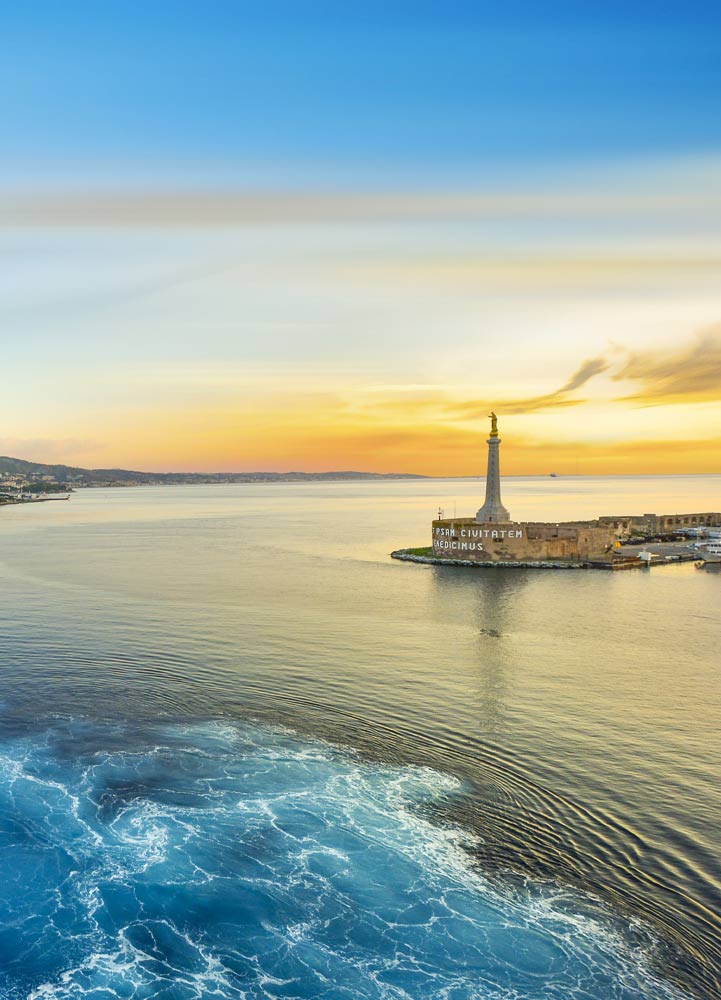
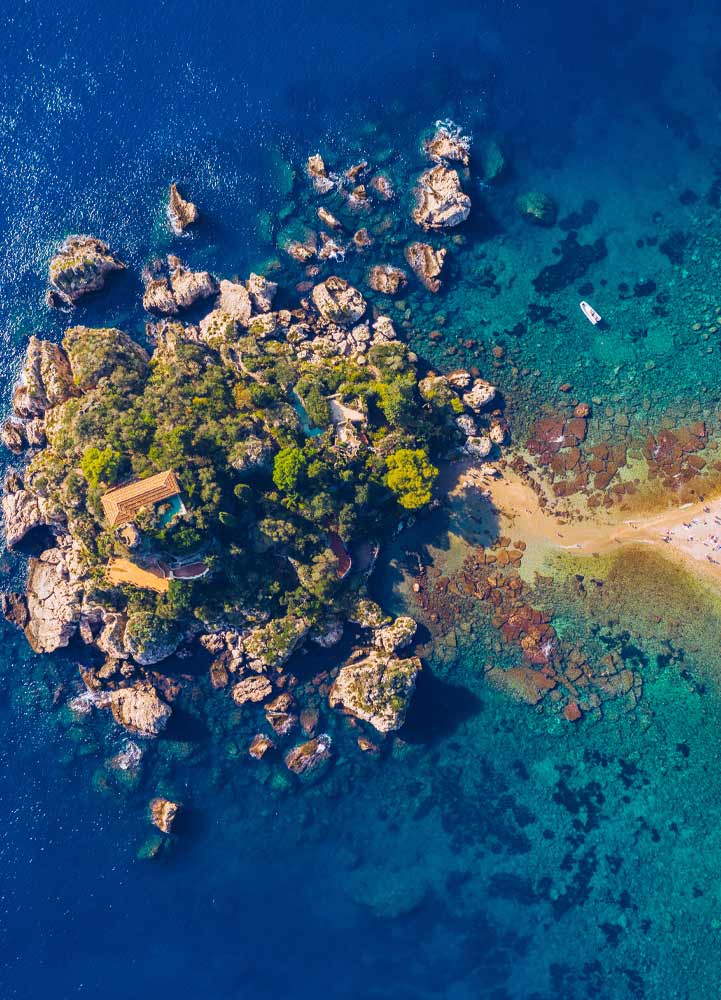
TAORMINA
Taormina
Taormina is quite popular for its stunning ancient theatre, characteristic side alleys and breathtaking vistas on the ionian sea. Taormina’s best-known attraction is the Greco Roman Theater, perched on a hill, overlooking the sea and with a perfect view of Mount Etna. This makes for an absolutely beautiful setting and the main subject of many a postcard and photo. Because of its remarkable preservation, the theatre is still used today for concerts, performances and re-enactments of greek tragedies. Below Taormina there is also a tiny islet, linked to the coast by a thin strip of sand called Isola Bella, depending on the tide it may be submerged or walkable.
One of the best experiences is to enjoy the quite spectacular descent with the cable car connecting Taormina to the coast, or going up after having enjoyed some time on the beach. Another point of interest is the nearby village of Castelmola, a medieval borgo with beautiful churches and building and a square overlooking the gulf, but also a very particular café: Bar Turrisi, where typical delicacies like pistachios sweets and the very particular almond vine can be tasted among phallic statues and paraphernalia, a quite interesting setting and an attraction for tourist in Sicily.
The nearest harbour with a marina is in Giardini Naxos, less than half an hour car transfer away, so that if one might be on the route a stop can be programmed here to enjoy the beauties of this destinations and more, as Catania and Mount Etna are just a small distance away.
ETNA
Etna
Mt Etna, one of the active volcanoes of Sicily, dominates the landscape of eastern Sicily. At a height of 3329 meters, it is Italy’s highest mountain south of the Alps and the largest active volcano in Europe.
It’s in an almost constant state of activity and eruptions occur frequently from the four summit craters, but more often, and more dangerously, from the fissures and old craters on the mountain’s flanks.
Since 1987 the volcano and its slopes have been part of a national park, called Parco dell’Etna with a varied landscape ranging from the severe, snow-capped mountain top to the lunar deserts of barren black lava, beech woods and lush vineyards where the area’s highly rated DOC wine is produced.
Starting from Milazzo or even Portorosa, it is possible to enjoy a day-long excursion to the Volcano, with rented cars, equipment and guides.
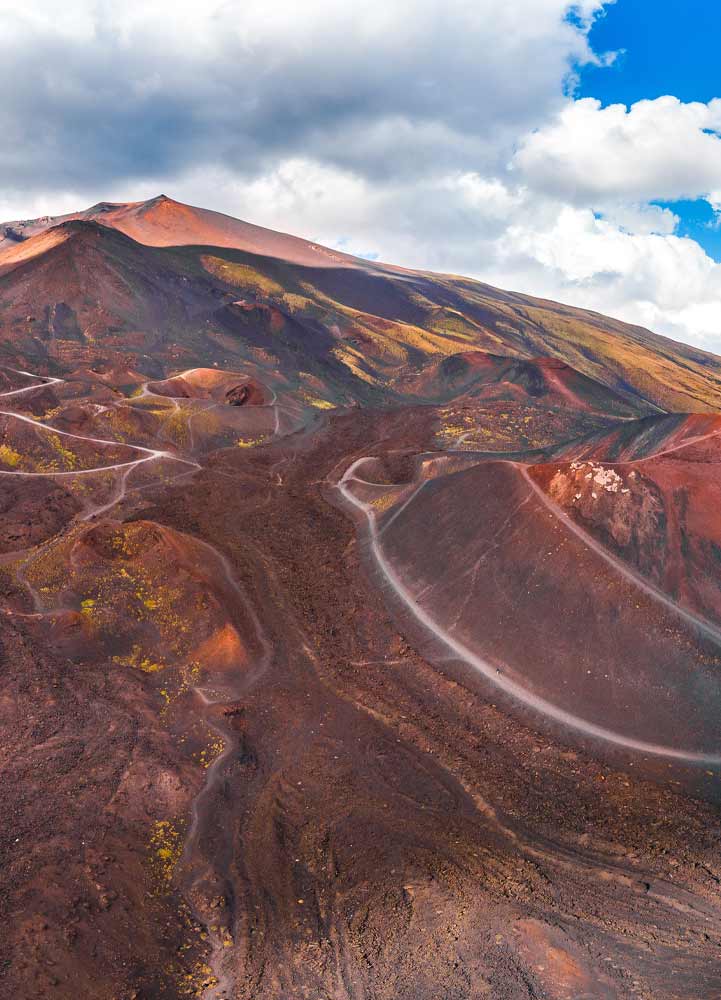
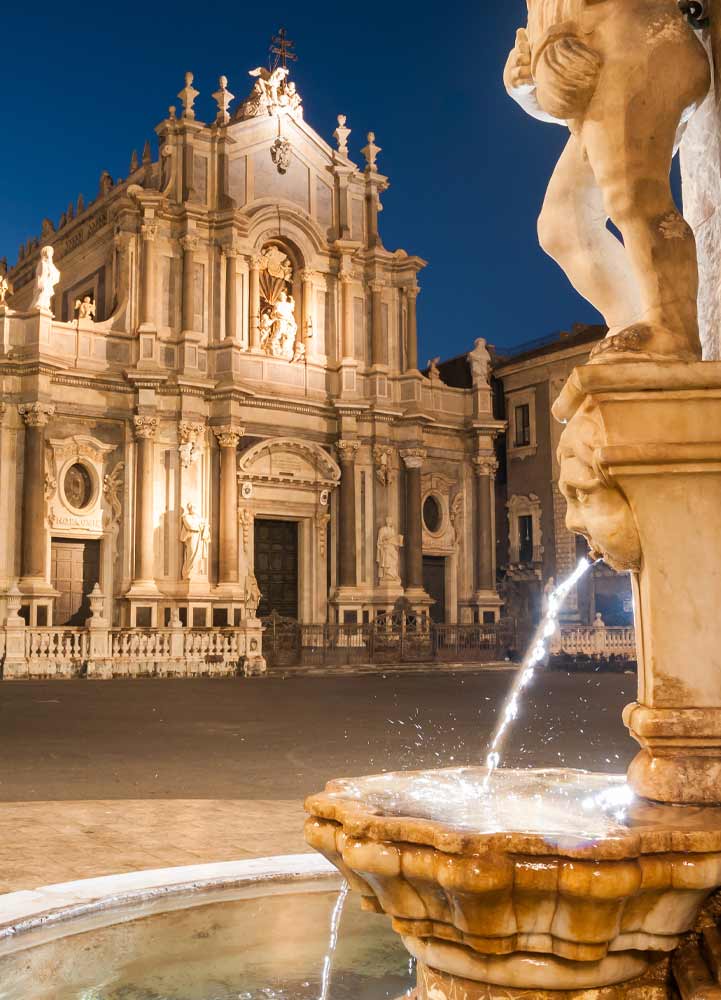
CATANIA
Catania
Catania’s historic center is a UNESCO-listed wonder, black-and-white palazzi tower over sweeping baroque piazzas. Beneath it, all are the ancient ruins of a town with over 2700 years of history and heritage. Catania is particularly well known for its street food: arancine, granita and the much-loved cipollina, a specialty made with puff pastry, tomato, onion, mozzarella and ham. This is also the home of Sicily’s iconic Pasta alla Norma and the extraordinary La Pescheria market. Catania’s patron saint is St. Agatha who was martyred here in the 3rd century is so well loved by the locals to merit a feast attracting people from all over the world and a particularly beautiful church: the Abbey of Saint Agatha.
Catania also offers a great deal of pubs, clubs and night entertainment for young and older people. The nearest harbour for sailing boats and catamarans is Riposto, resting in the shadow of Mt. Etna. At a distance of 33 nautical miles from Messina, the harbour offers many services and the possibility to fuel up.
There are also some lively festivals to enjoy, such as the Sagra delle Botti, a rollicking party where teams push wine barrels through the streets in a race, paying homage to the town’s past artisan craft of building barrels. There is also a Fish Festival every summer and a food fest that highlights the Arancina, a Sicilian specialty, though one must mention that in this side of the island it gets called Arancino, sparkling a century old feud between the inhabitants of different provinces of Sicily.
SIRACUSA
Siracusa
Siracusa encapsulates Sicily’s timeless beauty. Ancient Greek ruins rise out of lush citrus orchards, cafe tables spill onto dazzling baroque piazzas, and honey-hued medieval lanes lead down to the sparkling blue sea. Across the water from the mainland, Ortygia remains the city’s most beautiful corner, a casually chic and eclectic marvel.
The old town center of Siracusa bring to life 3000 years of history, from Apollo’s temple, the oldest Greek temple in Sicily, the way leads through picturesque narrow streets to the Cathedral Square, with its magnificent bright limestone buildings and the Cathedral itself, the only church still in use today which time ago was a pagan temple.
Not to be missed are also the enchanting Fountain of Arethusa near the sea, the less beaten paths of the Jewish Quarter and the local fish and fruit market to get a breath of local life, colors and scents. Not to be missed in the vicinity of Siracusa is Portopalo di Capo Passero in the most Southern tip of Sicily, it offers unspoiled and charming beaches with crystal clear turquoise waters that create a stunning and unmissable landscape, but also natural caves like the Grotta del Polipo, a natural grotto that offers spectacular light effects.
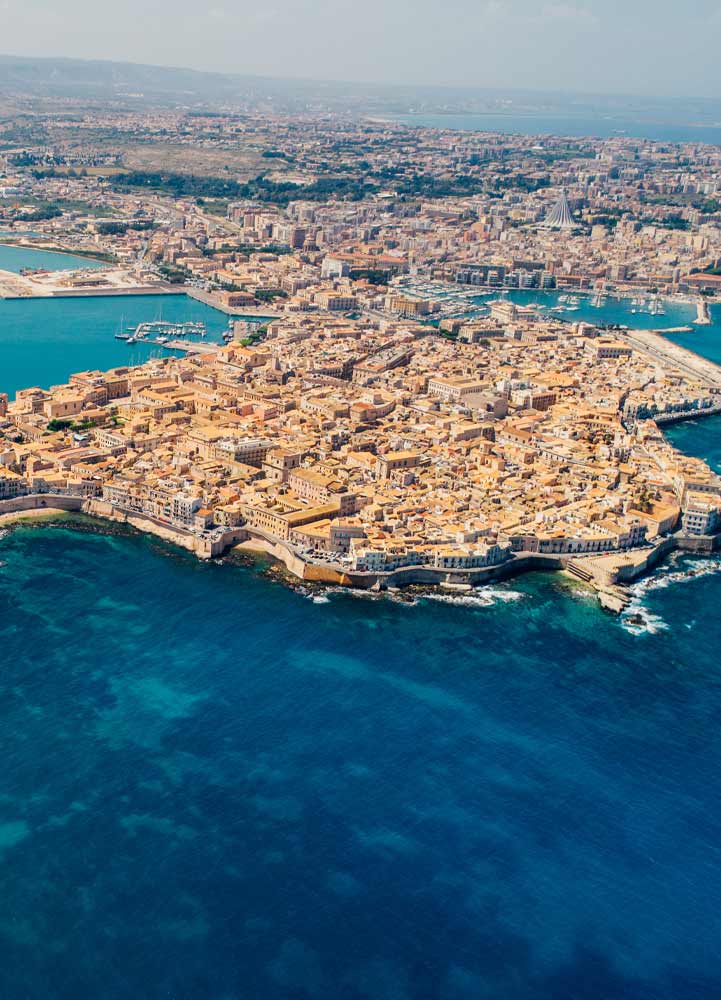
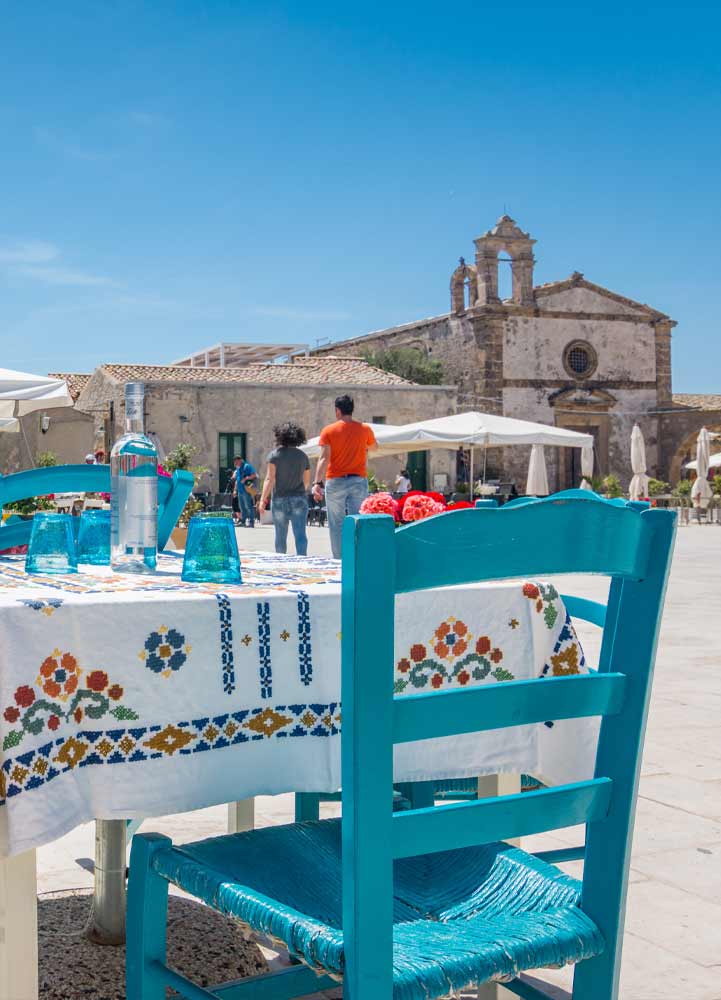
MARZAMEMI
Marzamemi
About 22 nautical miles from Siracusa is the quaint village of Marzamemi, fully immersed in the Natural reserve of Vendicari. It was the Arabs who gave the village its poetic name, Mars al-hamam (Turtle Dove Bay) but also built the original tonnara. Although the tonnara itself is no longer in function, Marzamemi continues its artisanal fishing and processing activities, producing all manner of delicacies like canned tuna, bottarga, smoked swordfish, seafood pasta condiments and much more besides.
The old center of the village is situated on a little promontory and organized around the extremely picturesque Piazza Regina Margherita. On the south side is the little fishing harbour with its bobbing fleet of colourful wooden boats, on the others a series of charming buildings, including the Church of San Francesco di Paola.
RAGUSA
Ragusa
The baroque city of Ragusa is a joy to wander with its labyrinthine lanes weaving through rock-grey palazzi that open onto beautiful, sun-drenched piazzas, it is situated in the mountains called Monti Iblei, but it has a very beautiful and well serviced harbour in the coastal town of Marina di Ragusa, from where it is possible to enjoy an excursion to the old city center, listed among the UNESCO Baroque towns of south-eastern Sicily.
Ragusa is also one of the principal filming locations for the Sicilian worldwide known detective drama Il Commissario Montalbano. The best activity in Ragusa is wandering; meandering along the character-filled lanes of Ragusa or clambering up the steps towards the upper town and enjoying the great, classic view over Ibla, the name of the oldest part of the city, a long drink at a cafe table on the pretty sloping piazza in front of the Duomo, a wine-flavoured gelato, a splendid meal at one of the town’s small restaurants or a stroll in the park.
But also in the vicinity of Ragusa there is much to see: like the castle called Castello di Donnafugata, a pseudo-Venetian-Gothic country villa in the countryside and other Baroque towns like Modica, famous for its chocolate as well as its architecture, the spectacular town of Noto, another UNESCO site, with its recently restored Cathedral.
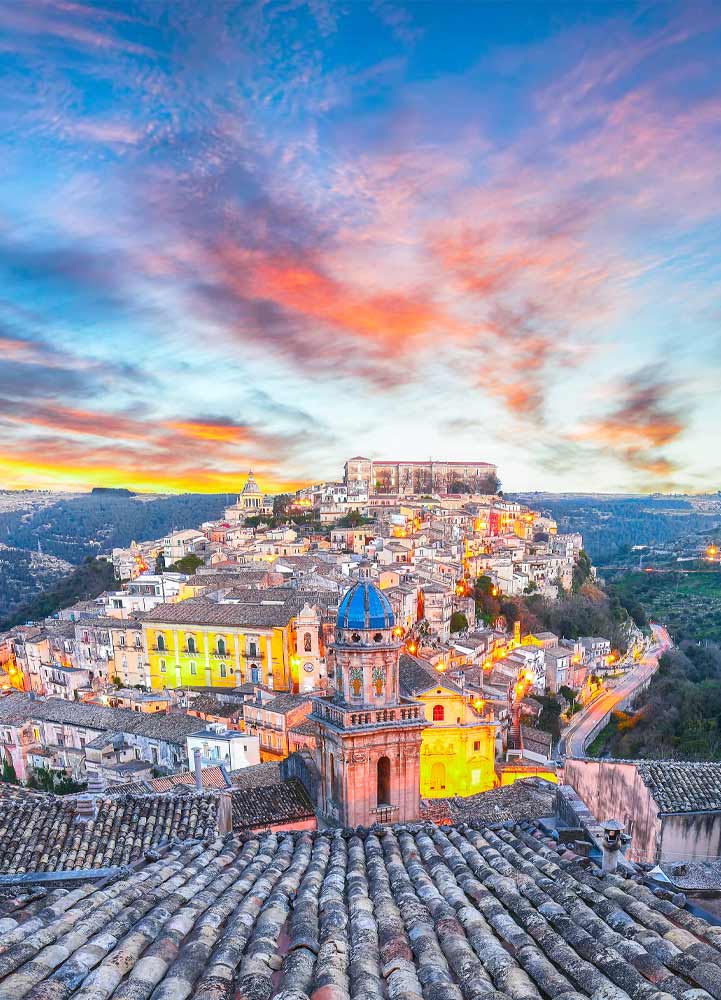
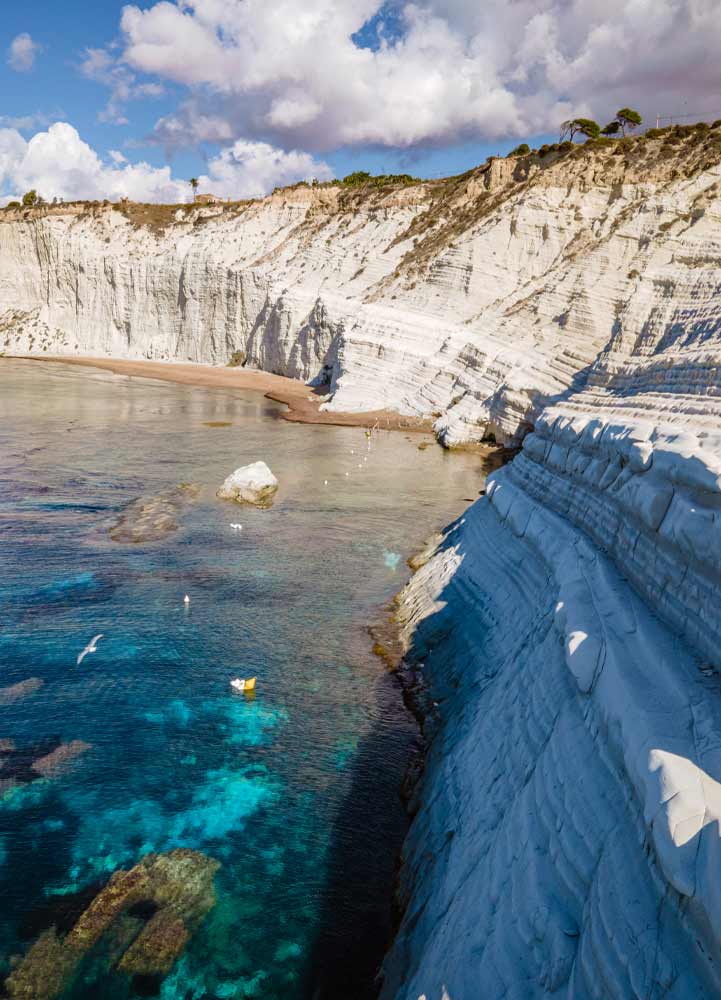
AGRIGENTO
Agrigento
Agrigento rises on a plain sheer above the sea. The town’s medieval core is the Via Atenea, an enchanting street lined with interesting shops, restaurants and cafès. Narrow lanes go upwards off the main street, past tightly packed mansions and historic churches.
A good range of accommodation makes the town an excellent base to explore the nearby Valley of the Temples and good beaches further west along the coast. The Valley of the Temples is an UNESCO World Heritage Site, it is one of the most important archaeological traces of the ancient Greeks, with many temples in near perfect state.
Still the best part of Agrigento is to be found on the coast. Many beautiful beaches of fine white sand that extend for kilometers, to the east and west and then the most beautiful sights in the area of Agrigento: the blindingly white rock outcropping, shaped like a giant staircase called Scala dei Turchi, about 15km west of the city It is a popular spot with local sunseekers, who come to sunbathe on the milky-smooth rock and dive into the crystal clear waters of sea, that are a true marvel of nature.
MALTA AND GOZO
Malta and Gozo
Malta and Gozo, are two truly amazing islands to visit for sea, sun, culture, high-end cuisine, attractions and all year round events, they are situated between 50 and 70 nautical miles from the south coast of Sicily depending on the starting point. The Islands’ scenery and architecture provide a spectacular backdrop and the colours are striking: honey-coloured stone against the deepest of Mediterranean blues. Malta’s landscape contrasts rocky stretches of coast that end in dizzying limestone cliffs with sheltered bays that hide crystal clear water and red-gold beaches. Snorkelers and divers have much to explore underwater as well, a world of caves, crags and wrecks.
There are many beautiful geologic formations along Malta’s coast, but one of the most beautiful and most popular is the Azure window, located near Dwejra Bay on Gozo, a natural limestone arch, over 28 meters high, and is thought to have formed when two limestone caves collapsed. The lagoon created by the arch has calm waters suitable for swimming and scuba diving and also the Blue Hole, a very deep hole in the sea bottom, encircled by stone shelves and just next to the arch. Very similar to a swimming pool of the deepest blue, it is a preferred spot for a swim and to take an instagram worthy photo!
In Gozo it is also possible to make tours of the Tal-Massar Winery where guests can partake in wine tasting accompanied by three traditional authentic Gozitan treats – Galletti with dips, sheep cheese and traditional bread with sun-dried tomatoes and cold pressed olive oil.
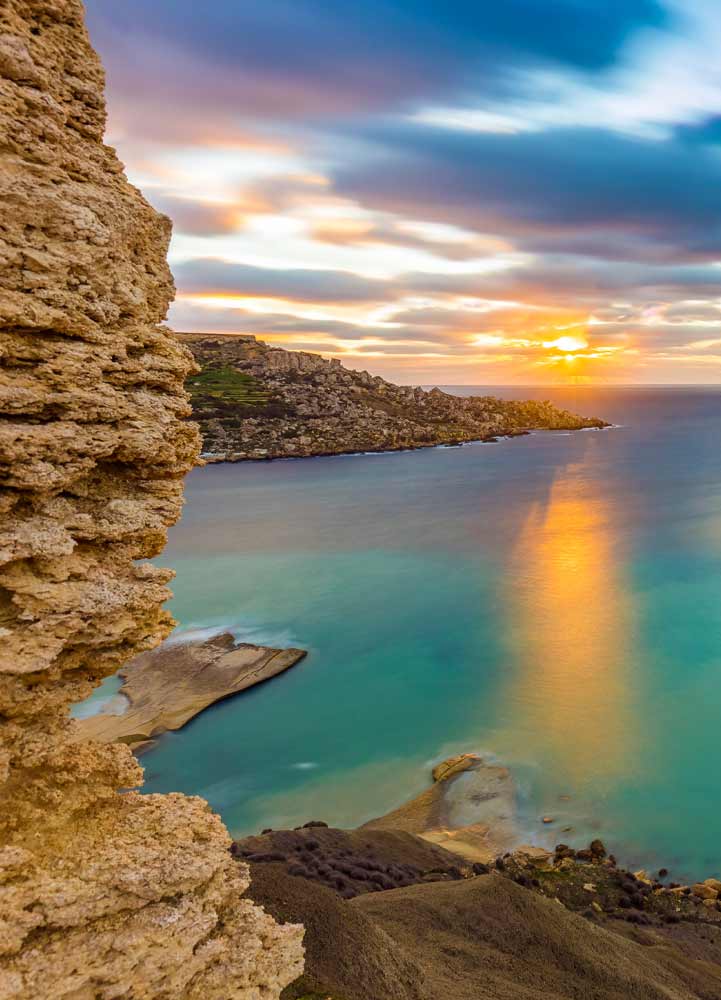
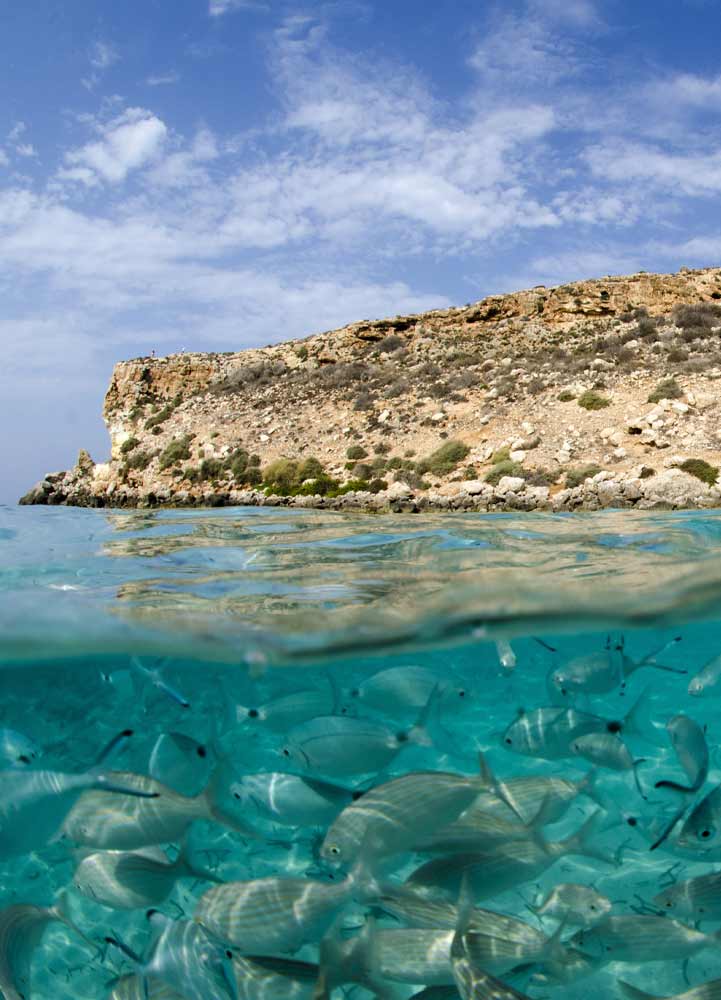
LAMPEDUSA
Lampedusa and Islands
Lampedusa, the largest of the three Pelagie Islands, the other two being Linosa and Lampione, a tiny boulder of an island) lies between 120 and 150 nautical miles south of Sicily. Surrounded by stunning turquoise waters, Lampedusa is a popular summer holiday destination. The main attraction is the beaches strung along the 11km southern coast.
The most famous, and one of the Mediterranean’s most beautiful, is Spiaggia dei Conigli (Rabbit Beach) at Isola dei Conigli, an amazing secluded bay lapped by shallow, aquamarine waters. The beach is part of a nature reserve because the Caretta caretta (loggerhead sea turtles) lay here their eggs between May and August. Other beaches include La Tabaccara, a very beautiful cove where the boats seem fly as there is no difference between the color of the sky and that of the water, Cala Francese, Cala Galera, Cala Pisana, Cala Uccello and Cala Greca.
Lampedusa is also famous for the fish couscous, cooked with a mix of African and Sicilian flavors with shrimp, lobster, plus other seafood added to the original receipt and accompanied with delicious white wines. Linosa is only about five square kilometers in size, with much of the island scenery away from the shore dominated by the three extinct volcanoes and beaches of black volcanic sand. The harbour and town, to the south of the island, owes as much to African architecture as Italian, with small flat-roofed houses painted in bright and pastel colours.
The main places worth a visit on Linosa are Cala Pozzolana di Ponente and Punta Beppe Tuccio, where diving is possible also the Faraglioni on the east coast and Cala dei Fili, with its white sea-sand. Lampione is simply a great flat and wide rock in the middle of the sea.